The Duce’s mighty battleships: Italy had to wait after the expiration of the Washington treaty ban to start its first modern battleship class, and accommodations by the treaty of London. The Littorio class was designed to answer another ship’s class specifically, the French Dunkirk class, which themselves answered the German Deutschland class of 1929. Four were planned over time, the second pair meant to deal with the new French Richelieu in construction, but only one of this new pair was completed, in 1942. They were the best, most modern and last battleships Italy ever had, armed with 381 mm (15.0 in) in a “classic” configuration of the time of 3×3 guns and were capable of 30 knots (56 km/h; 35 mph) as true fast battleships. The design was also considered by the Spanish Navy, but thwarted by WW2 breaking out. Their active life was marked by several battles, like Cape Matapan, but they were also attacked at Taranto in 1940 and La Spezia by June 1943, or by German aviation’s guided bombs when en route to Malta after the armistice. before they were to be interned in Alexandria. Roma was sunk by arguably the ancestors of antiship missiles. With a better command and less hesitation, the lack of radar and coordination aviation aside, these battleships individually were considered with respect by the Royal Navy, for good reasons.
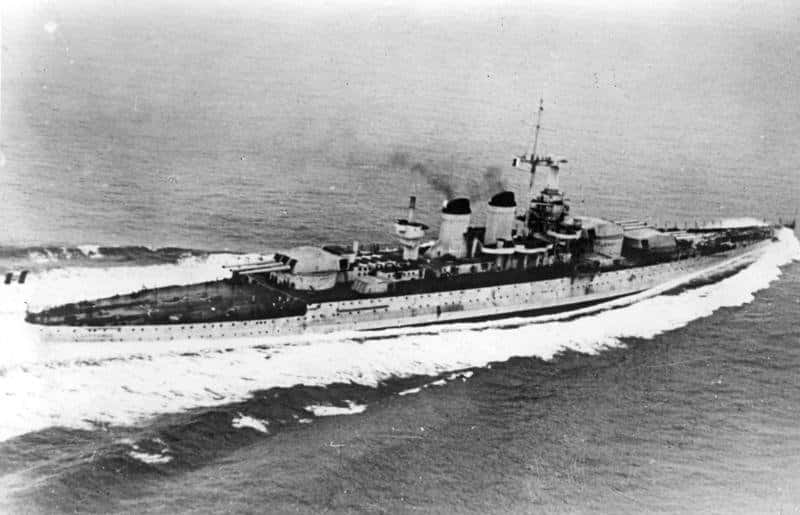
Littorio sailing for completion
Development History of the littorio class
The littorio class did not happened out of the blue. The interwar was a prolific period for proposals, from yards or officers, even though the moratorium dictated patience. The last unbuilt dreadnought design was the Carracciolo class, arguably the first Italian “super-dreadnought”. Indeed she was the fastest planned (28 knots), and armed with eight 381 mm guns, perfect rival for the Queen Elisabeth class while the French had nothing to compare. In 1919, their successor, “Progetto G” were a pair of 37,000 tonnes, four quadruple turrets behemoths with the same caliber. They were comparable to the French Lyon class.
Since Italy signed the Washington Naval Treaty in 1922, 70,000 long tons of total capital ship tonnage was alloted, so a pair of 35,000 tonnes battleships. This would be of some use from 1927–1929, as far as went the “holiday” construction. France had the same tonnage and both pressured other signatories to grant them construction of smaller battleships with reduced calibers. Therefore the first Italian design came out in 1928, and like the French, called for a 23,000 long tons design with six 381 mm (15.0 in) main guns in twin turrets. This allowed three ships to be built instead of one. This triplet alloted the Regia Marina to have at least two units operational at any given time. Protection and range were sacrificed for speed and armament.
The same yeat, the design staff prepared another design, this time for a pair of battleship 35,000 long tons in displacement and with six 406 mm (16.0 in) main guns. Protection would be able to defeat same caliber rounds. The holiday was to expire in 1931 and until the, funding was not allocated to start any construction, also the politicians did not wanted to start an arm’s race with France due to the state of the economy. The London Naval Treaty extended the building holiday to 1936, but still, both Italy and France could use this 70,000 tonnes before, refusing the Britih proposal to limit them to 25,000 long tons with 305 mm guns. Around 1932, the light battleship design was eventually abandoned while the French laid down the two Dunkerque-class battleships. The naval staff ordered a design to answer at first the Deutschland class, but with six 343 mm (13.5 in) guns in triple turrets to face the French designs, on a 18,000 long tons displacement, but it was revised for a larger design.
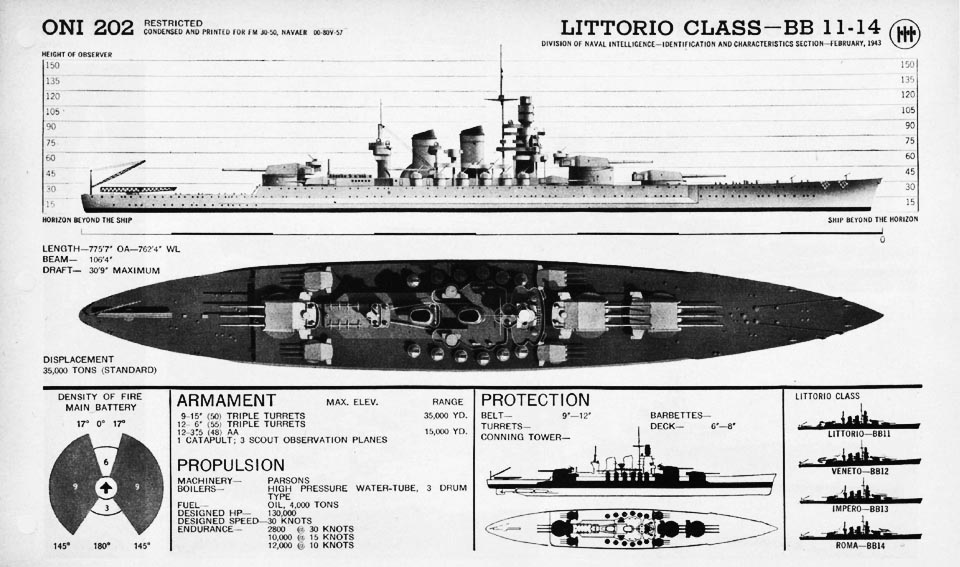
Littorio recoignition plate – ONI
A 26,500 long tons (26,900 t) design was prepared in 1933, with eight 343 mm guns in twin turrets, giving one gun advantage over the French Dunkirk. However it was soon superseded by another 35,000 ton design, with 406 mm guns, later revised more realistically to a known 381 mm caliber, which had bee already developed for the Carraciolo, and this did not added further delays. The last design called for nine 381 mm guns in three triple turrets. However as the design was refined in 1934 to include the right level or protection and range, the displacement rose to 40,000 long tons, even it violated the established treaties. By the time they entered service, the major naval powers invoked the “escalator clause” and grand themselves a 45,000 long tons displacement. The final design was approved and construction started.
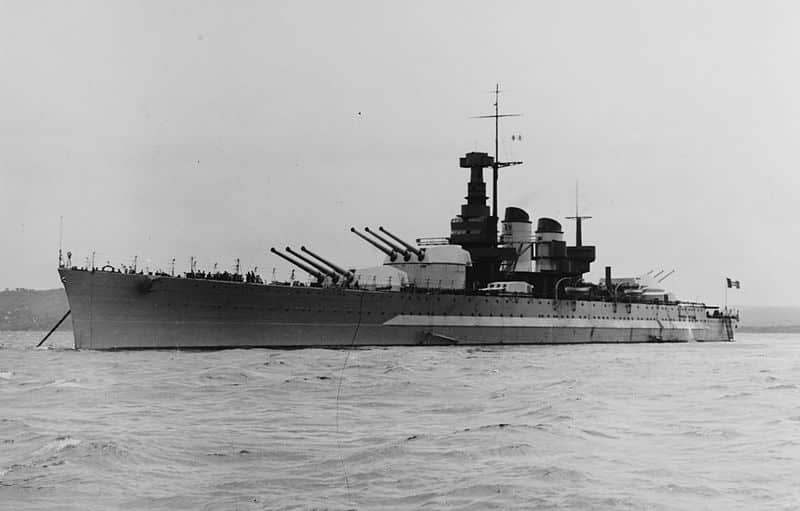
Veneto shortly after completion
Design of the littorio class
General characteristics
The first pair, Littorio and Vittorio Veneto were 224.05 meters (735.1 ft) long between perpendiculars, 237.76 m (780.1 ft) long overall. The next one will be longer (see later). All four ships would have the same draft of 9.6 m (31 ft) and beam of 32.82 m (107.7 ft). Displacement diverged between the first two, 40,724 metric tons for Littorio as designed (45,236 t FL) and 40,517 t for Vittorio Veneto (44,318 long tons FL). They had a bulbous bow which caused problems and was revised for the next two. The peacetime crew was 80 officers and 1,750 enlisted men, and as flagships, 11-31 additional officers. The Roma and Impero had about 100 additional enlisted men to man the superior AA. The basic design called for three triple turrets and the rest of the design followed around. These turrets were relatively closed (A-B close to X) in order to reduced the length of the citadel and thus, making the ships lighter.
As a result, superstructures, the bridge, smokestack and aft mainmast were all closed together in the center portion of the ship, representing around 1/3 of the total length. Their tower bridge, close funnels and hull’s long forecastle stopping just aft of X barbette have them quite a unique appearance. The tower bridge comprised two control decks, one for the captain and staff, and one above for the admiral and his staff when used as a flagship. The main mast was attached to it, with radio cables running to the aft mast installed above the aft tower. Above that were located the two main armoured rangefinder, for the main forward turrets A and B. The base was the conning tower. A second conning tower was installed aft with a rangefinder for the X turret, behind the aft funnel.
Propulsion
The propulsion system accounted for circa 5.6 % of the total displacement and consisted of four Belluzzo geared steam turbines. Steam came from eight oil-fired Yarrow boilers. Total output was about 128,200 shaft horsepower (95,600 kW) for 30 knots (56 km/h; 35 mph) as designed. On sea trials, both battleships were beyond, 31.3 kn for the first (on 137,649 shp) and Vittorio Veneto 31.4 kn (133,771 shp), at light loads (no ammunition, reduced water and oil). In service to spare the machinery, this was reduced to 28 knots (52 km/h; 32 mph) in practice. Roma speed trials were been recorded and so her top speed is not known. Both carried 4,140 t of fuel oil for a theoretical range of 4,580 nautical miles at 16 knots cruising speed, greater at 14 kn (4,700 nmi). The powerplant was kept identical for the Roma class.
Armament
Main battery guns, 381 mm/50
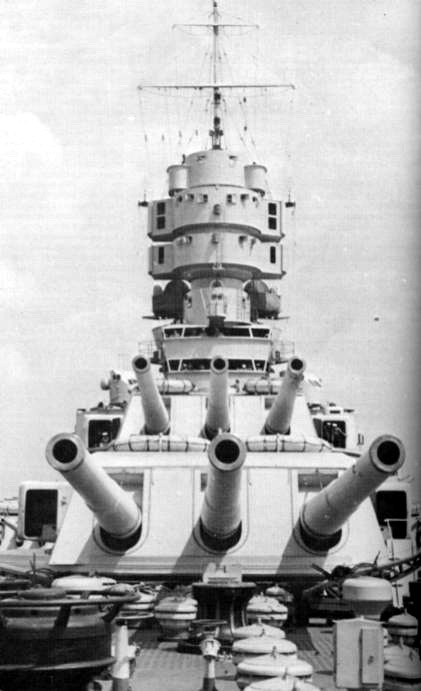
The main battery was soon fixed to nine 381 mm L/50 Ansaldo 1934 guns, and in three triple turrets. The choice was just to not spent time developing a new 406 mm model as previously envisioned, hand not to waste the already existing 381 mm developed for the Carraciolo, of which many barrels were already in storage. The modello 34 was an evolved version of the latter.
Compared t the previous 16-in (406 mm) planned, the modello 34 barrel had a longer barrel, and subsequently fired a higher velocity shell to compensate. Indeed, the 381 mm/40 (15″) Modello 1914 was a 40 caliber, firing an AP shell of 1,949 lbs. (884 kg) or HE of 1,949 lbs. (884 kg) loaded with around 50 kg trotyl at 2,297 fps (700 mps).
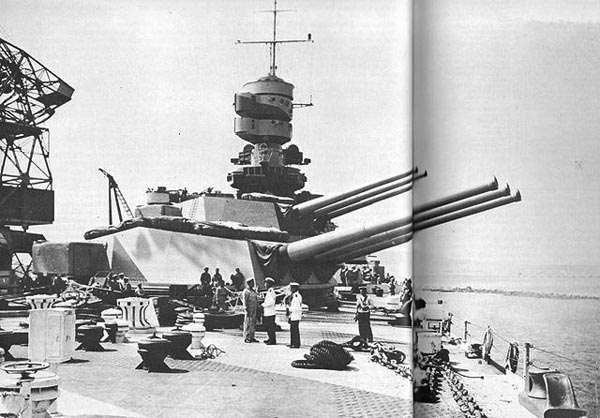
The Ansaldo modello 34 was a 50 caliber. It was quite a powerful weapon for its caliber (maximum range well above the artillery pieces of this caliber, British included). A superb performance paid by excessive dispersion and very short barrel life. The gun was refined to the Modello 1939 for Roma and Impero. Some were also built by Odero-Terni-Orlando (OTO). These were complex guns, wit were six major components rather than four as ususal, with A tube in two layers, the outer layer continuing to the muzzle. The jacket was over 72% of the total length while the breech bush was screwed into the jacket. There was also a loose liner to improve the barrel life. They used a Welin breech-block, hydro-pneumatically operated and compressed-air smoke scavenging system.
The classic artillery configuration of a superfiring pair forward and one aft was also favored by the US Navy, and with a variation, the British Navy. Maximum elevation was 35 degrees,giving a theoretical range of 42,260 m (46,220 yd), which was excellent. Muzzle velocity was 870 meters per second (2,854 ft/s), down to 850 m/s (2,789 ft/s) to reduce dispersion and increase barrel life. The guns also fired the new SAP or semi-armor piercing shells (824.3 kg, 1,817 lb) with a 29.51 kg (65.1 lb) bursting charge. HE shells weighted only 774 kg (1,706 lb) but they never saw service. The ammo rooms were located below the propellant magazines, and beneath the turret’s gun house. RPM on average was 45 seconds. The ship carried in total 495 AP and 171 SAP shells.
Secondary battery, 152 mm/55
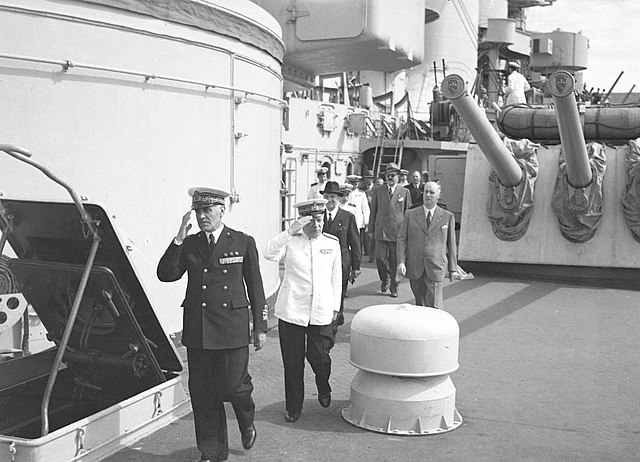
Admiral Carlo Bergamini on the deck of Roma, on the background, the ship’s right turret
These twelve 6.0 in L/55 Ansaldo Modello 1934 were the equivalent of a powerful light cruiser, with four triple turrets, a pair mounted abreast ‘B’ turret and the remainder abreast ‘X’ turret.
The modello 34 also shared by the Garibaldi class cruisers was designed from 1934 to 1936, tested and entered service in 1940. It weighted 8.9 tons (9,689 kg) and measured 348 in (8.840 m) overall. The chamber volume was 1,537 in3 (25.19 dm3) and its rate Of Fire was 4-5 rpm. It fired a 50 kg (110 lb) AP shell at 910 m/s (2,986 ft/s) of muzzle velocity and the gun cradle could elevate it to 45° for a range (maximum) of 25,740 m (28,150 yd).
Tertiary battery, 120 mm/40
Four 120 mm (4.7 in) L/40 guns were also present on the Littorio class battleship. Short barrel, low-velocity, their only task was to fire illumination rounds for night fighting. They elevated to 32 degrees, firing a 29.3 kg (65 lb) semi-fixed illumination round at 5,000 m (16,400 ft).
AA battery, 90 mm, 37, 20mm
The Littorio class BBs’ AA armament comprised a powerful battery, better adapted to the time (revised after the design started in 1934), of twelve 90 mm (3.5 in) L/50 guns. They were all mounted in a cluster amidships. Developed by Ansaldo, and shared by the Duilio and Littorio classes, they derived from a 1915 AA model, and had good ballistic properties for their caliber. However the modello 1939 had stabilized mountings too advanced for their time,and they accumulated technical issues, electrical and mechanical breakdowns plaguing their service early years. The mountings were stabilized in four axes and integrated roll and pitch corrections. They had eleven gyros integrated in a very complex arrangement only to maintain stabilization. Their gun barrel was an autofretted monobloc model with a screwed-on breech ring. The latter held the horizontal sliding breech block and seatings for recoil cylinders. It was attached to the receiver by a bayonet joint. The land model was a 90 mm/53 gun considered by meany expert better even than the German 88 mm. The Regia Marina had such trust in these, in 1938 plans were made to rebuild the Alberico da Barbiano class into AA cruisers. They fired a 7.5 lbs. (3.4 kg) frag shell, at 2,822 fps (860 mps), 12 rounds per minute and circa 10,800 m (35,400 ft) of ceiling. The guns servants were well protected by the turret. The Littorio class carried 487 rounds per gun, so 5844 in all, and 23,376 for all four battleships less spares stocks.
The light AA artillery comprised twenty Breda 37 mm (1.5 in) L/54 guns, and sixteen Breda 20 mm (0.79 in) L/65 guns. They completed this close-range defense with ranged of 4,000 m (13,100 ft) and 2,500 m (8,200 ft) respectively. All in all (including the additions on the Roma class), this AA was one of the best fielded on any axis battleship, but the Bismarck and Yamato class. This was enough for the Germans to not even attempt direct attacks on these ships in 1943 and used guided bombs instead.
Onboard aviation
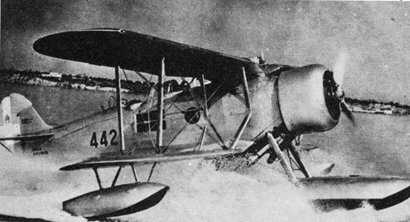
The Littorio class carried three floatplanes, launched from the aft deck catapult. Aircraft facilities were located on the quarterdeck. The initial plan was to house and operate six La Cierva autogyros (The Italians acquired the licence), making these potentially the first helicopter-carrier battleships. However a more classic approach was chosen, and a single catapult was fitted, operating three Ro.43 reconnaissance seaplanes. During wartime, the ships also carried navalized Re.2000 fighters, wheeled aircraft which needed to land on solid ground but procured speed and some additional AA defence to the ship. None operated them when attacked either by He 111 or Do 217 in 1943.
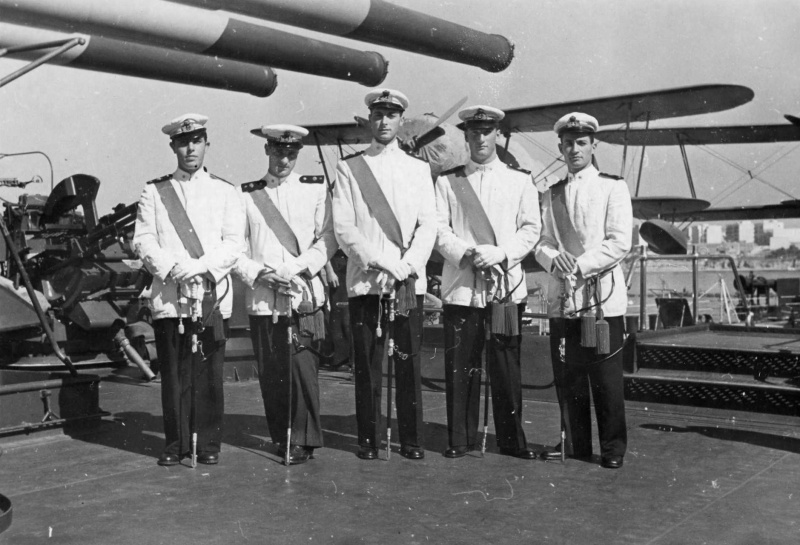
Officers posing in front of their Imam Ro.42 Idro on their catapult aft deck of RN Vittorio Veneto.
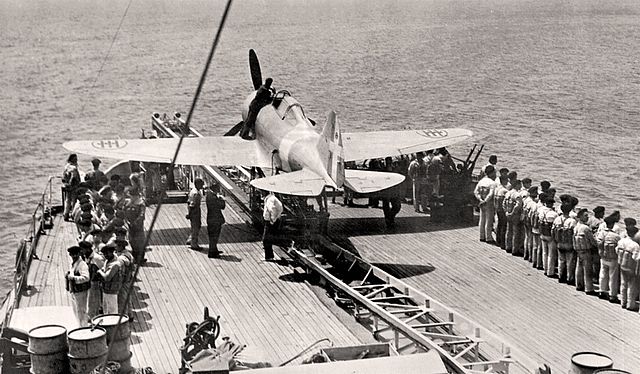
Reggiane Re 2000 catapulted from RN Veneto.
Richelieu’s answer: The Roma class (1940)
As soon as the Richelieu class was laid down, the Regia Marina ordered the Roma class, comprising Roma and Impero. The first was laid down at Cantieri Riuniti dell’Adriatico, Trieste (Vitorrio Veneto’s yard), and launched in Jun 1940 and completed two years later. Impero was laid down at Ansaldo, Genoa-Sestri Ponente, Littorio’s Yard, on 14 May 1938, sooner than Roma (September), and launched also sooner, on 15 November 1939 but as war progressed all work stopped.
Roma and Impero had significant differences incorporated in their design, with the lessons learned with the first two battleships. They were significantly longer at 240.68 m (789.6 ft) long overall on the same breadth, and displacement reflected this. Roma’s displacement was 40,992 t standard and 45,485 t FL while Impero’s figured are not known. As built, they had a modified bow in order to not repeats the problems of the previous class. Their AA was also slightly improved with twenty instead of sixteen Breda 20 mm guns. It was good enough to not be radically increase whereas the design was dating back from 1933.
Protection of the Littorio class
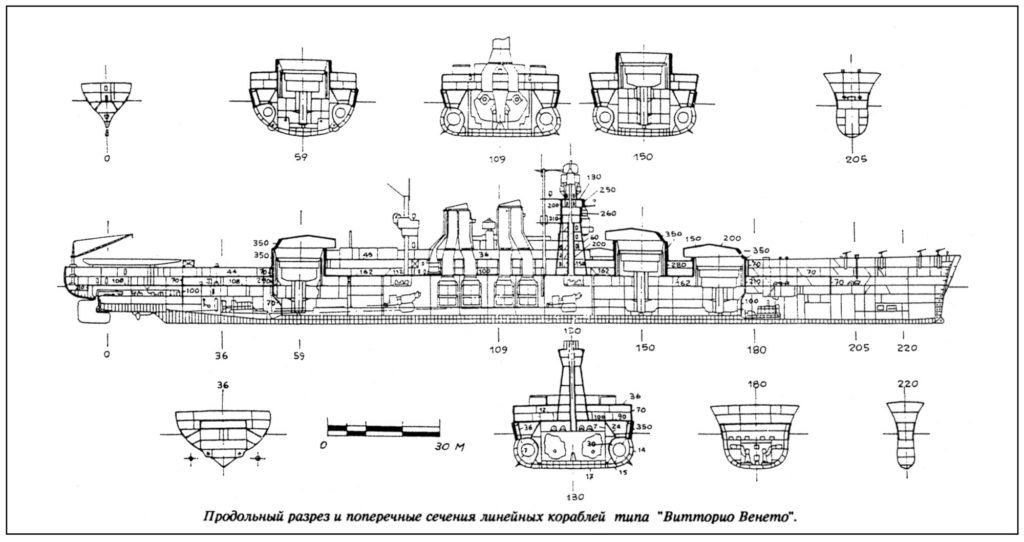
Vitorrio Veneto armor scheme
The level of armor protection was the best ever fitted to any Italian battleships, and one of the best compared to its contemporaries. One of its shining innovation was the Pugliese system.
The main belt armor was designed and tested to resist same-caliber (381 mm) armor-piercing shells at ranges of 16,000 m (17,000 yd), the optimal inner edge in combat. It comprised a 70 mm (2.8 in) homogeneous armor for the outer plate and 280 mm (11 in) cemented armor belt, 250 mm (9.8 in) behind it. The 250 mm gap was filed with a cement foam. It was called “Cellulite” and its role was to keep the water out of this gap. It could also brake armor piercing shells energy. This main armor belt was also backed by 150 mm (5.9 in) of oak timber, plus 15 mm (0.59 in) steel backing just behind with softer steel to trap shapnells, making a sandwich perfect to absorb energy.
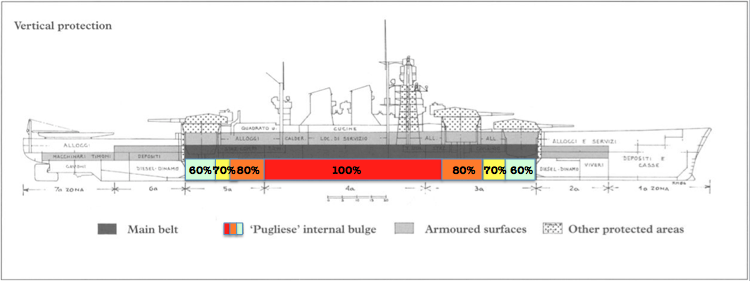
Schematics of the protection of the Littorio class
Belt armor
The entire belt was sloped to 11-15º inwards, the slope depending on the section of the hull. There was a 36 mm (1.4 in) homogeneous armor plate mounted also 1.4 m (4.6 ft) behind the belt and another 4 m (13 ft) behind backed again by another 24 mm (0.94 in) stray plating, with a 26º slope in the opposite direction to stop bouncing shells that coukld have penetrated from above. The main citadel was closed by traverse bulkheads 100–210 mm (3.9–8.3 in) thick forward and 70–280 mm (2.8–11.0 in) aft. Above the citadel the was an armored casemate protected uniformly by 70 mm (2.8 in) HT steel plating. The bow itself was also reinforced, and protected by a 130 mm (5.1 in) belt extending 35 m (115 ft) ahead of the main belt. It was closed by its own 60 mm (2.4 in) transverse bulkhead. Additionally there was an aft 100 mm (3.9 in) homogeneous armor plating over the propeller shafts and aft diesel generator groups, plus the steering gear, including a 200 mm (7.9 in) bulkhead aft of the citadel.
Deck armor
The weather deck over the citadel had a 36 mm (1.4 in) homogeneous armor plating, over a stray of 9 mm (0.35 in) plate. The main armor deck had a variable thickness depending on the area protected, 150 mm (5.9 in) of homogeneous armor laminated over the magazines, superposed to a 12 mm (0.47 in) deck plating inboard, 100 mm (3.9 in) on 12 mm for the plating outboard. It was was 100 mm on 12 mm inboard, 90 mm on 12 mm outboard over the machinery spaces. This main armor extends to the ends, 60 mm (2.4 in) over 10 mm to the bow, and 36 mm (1.4 in) over 8 mm over the stern.
Artillery protection
Main battery turrets protection was 380 mm (15 in) with cemented armor for faces, thinned to 200 mm (7.9 in) for the sides and roof and 130 mm (5.1 in) on the rear sides and back, 150 mm (5.9 in) on the rear roof slope and 350 mm (14 in) for the back plate. They were mounted in barbettes which had walls 350 mm (14 in) thick above the upper deck, 280 mm (11 in) below. The Secondary battery turrets protection was just 280 mm (11 in) for the faces, down to 80–130 mm (3.1–5.1 in) for the sides, with a back plate of 80 mm (3.1 in) and 105–150 mm (4.1–5.9 in) roof. Their their barbettes also varied over and below the armored deck, from 150 mm (5.9 in) to 100 mm (3.9 in). Protection stopped below the third deck, at their basis. The 90-mm AA mounts had 12 mm (0.47) shields and 40 mm (1.57 in) barbette walls, with wells extending below the third deck.
The forward conning tower was designd by General Pugliese and had elliptical walls with 255 mm (10.0 in) on the front section, and 175 mm (6.9 in) from the side to the rear, backed by anti-shrapnell soft steel 25 mm (0.98 in) plating. The lower two levels were 250 mm (9.8 in) and 200 mm (7.9 in) backed by 10 mm (0.39 in) plating. The roof was protected by 90–120 mm (3.5–4.7 in) on 10 mm plating. Below the decks the well was still 200 mm (7.9 in) thick, the tube containing electrical cables and pipes for hydraulic systems.
Pugliese torpedo defense system

Middle section armor belt and pugliese system schematics
All four ships were signalled by a long-thought and quite unique underwater protection system. It was named after its designer, General Umberto Pugliese.
It consisted in a 40 mm thick torpedo bulkhead, which extended inboard from the base of the main belt, and sloped down to meet the hull bottom. It ormed a void, containing an empty space 3,800 mm (150 in) wide, surrounded by 6 mm (0.24 in) thick plating. The void left was liquid-filled. The cylindrical “drum” ran the length of the torpedo bulkhead. It was designed to collapse under the explosive pressure of a torpedo warhead and prevent any splinters or contain explosion effects. All these layered protection was far enough from the vitals to protect them. The system was designed to sustain a 350 kg (770 lb) warhead hit. Fortunately for Pugliese its system was live tested in combat as the Littorio and Vittorio Veneto were torpedoed several times during their career. 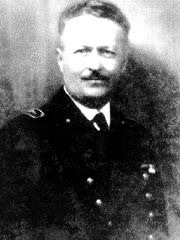
These torpedo attacks however revealed faults in the system: This was due to two major defects, weak riveted joints between the interior torpedo bulkhead and hull bottom, failing in cases of near misses, and preventing the hollow drum’s collapse as planned (and causing massive flooding). The width of the drum was reduced also abreast of the main battery from 3.6 down to 2,28 m (90 in) and its capacity to absorb explosive the blast was reduced in these sections where it mattered more, for the sake of finer hull lines.
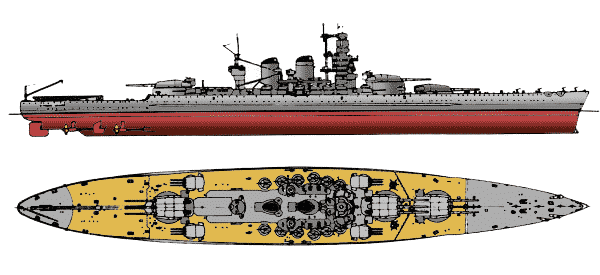
2-view drawing of the Littorio
The Spanish Littorio (Progetto 1047)
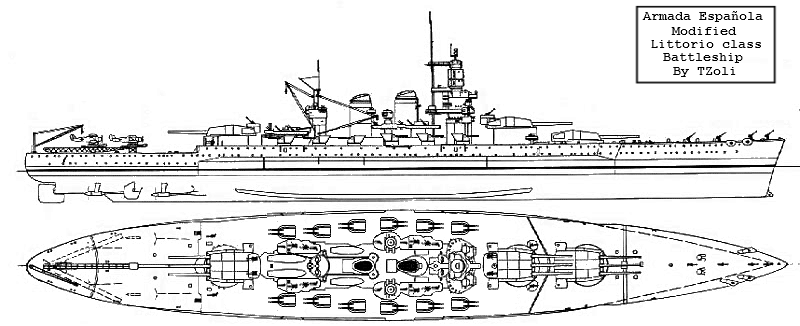
Rendition of the Spanish Littorio, showing its unusual secondary battery
In 1939 General Francisco Franco came out the victor of the Spanish civil war and contemplated an ambitious naval program. Franco concluded agreements with the Italian government, which already provided him during the war submarines and destroyers, and discussed the major issue of building no less than four Littorio-class battleships in Spain, under Italian assistance and plans. The agreement was made as the Ansaldo shipyard, chosen for the deal, was to draft plans for a virtual copy of the littorio with some modifications and to provide all necessary technical and material support for the construction in Spain, starting at Ferrol Shipyards. The Italian Navy also devised a plan to both modernize, expand and enlarge Spanish shipyards in order to support the construction of these much larger ships Spain ever saw. However the project was abandoned when Italy declared war on France in June 1940, whereas the state of Spanish industry back them was seen as a serious handicap, in addition to crippling budgetary issues. The plan was never revived and dropped after the war. These “Spanish Littorio” were similar to the exception of the secondary turrets, which seemed based on local models develop to modernize the 1920s cruisers during their reconstruction. Would these four ships had been built, without assistance of Italy, they would probably have been completed in 1945-47 and therefore obsolete at that stage.
The super-Littorio (Progetto UP.41)
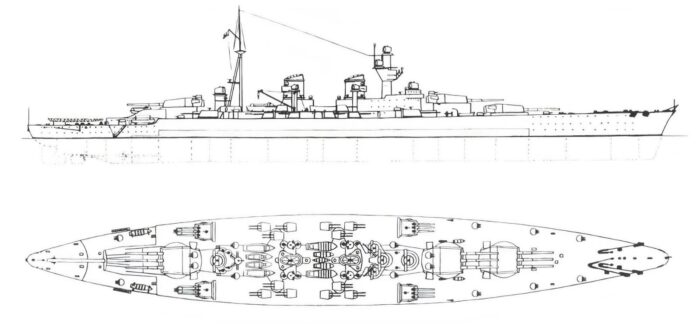
In the early 1930s, the Soviet Navy sought advice of Italy for its battleships and on 14 July 1939, Ansaldo completed a design proposal largely based on the Littorio class. It was designated U.P.41. and called for a 42,000 t battleship armed with nine 406 mm guns in triple turrets and twelve 152/55 mm, twenty four 90/53 mm in twin turrets, and 37 mm in quadruple mounts. The powerplant was more powerful in order to expect a top speed around 28 knots.
Specifications of the Pugliese system was undisclosed to the Soviets, and instead a simpler multiple-torpedo bulkhead system was drafted. The Soviet Navy did not used this design although the Sovetsky Soyuz-class laid down at the same time was still close in many aspects. And these battleships were equipped with the Pugliese system, obtained through Soviet espionage.
While preparing the type 1047 battlecruisers in early 1940, the Dutch Navy sent a delegation to see the Vittorio Veneto under construction, hoping to have glimpses of the Italian underwater protection system, which was considered a military secret.
This project passed the 40,000 t limit and would probably reached fully loaded 50,000 tons, violating the Washington treaty. However escalation was already started.
In 1938 already two additional Littorio class vessels were ordered Admiral Pini’s project was opposed by Cavagnari for budgetary reasons and later thwarted by the lack of facilities.
The major problem to built a successor of the Littorio class in Italy was that not drydock could contain such battleships so authorities planned at first the construction of a new, massive drydock and its facilities in Taranto. The project went on during the war, and until 1941, but by the, with limited industrial capacities and shortage or men and materials, it became obvious this would not be completed in 5-6 years.
Links
Note: First published in November, 11, 2016
Specs Conway’s all the world fighting ships 1922-1947.
www.navweaps.com/Weapons/WNIT_35-50_m1939.php
www.navweaps.com/Weapons/WNIT_Main.php
https://it.wikipedia.org/wiki/90/53_Mod._1939
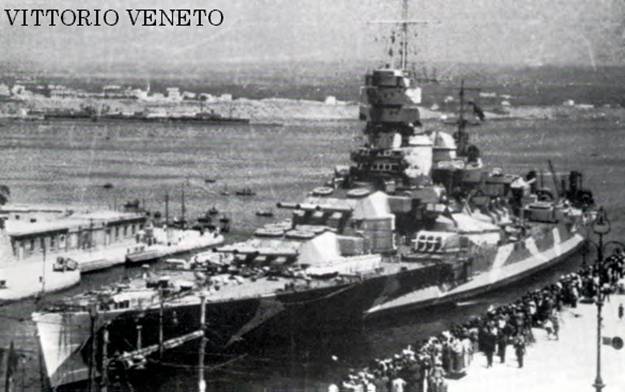
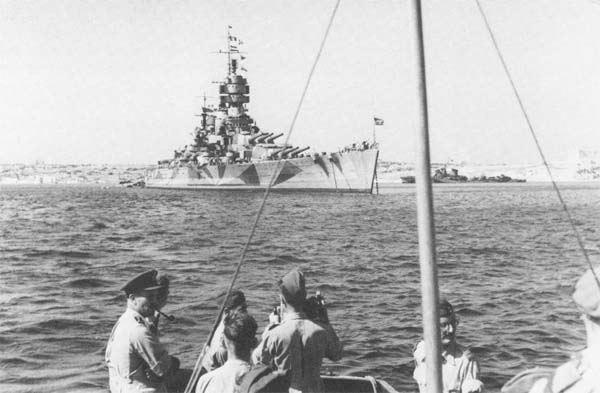
Vitorio Veneto in berth (date unknown), and in Malta


littorio and Vittorio Veneto, illustrations by the author
Littorio specifications 1940 |
|
| Dimensions | 237.76 m (780.1 ft) x 32.82 m (107.7 ft) x 9.6 m (31 ft) |
| Displacement | Standard: 40,724 t, Fully loaded 45,236 t |
| Crew | 80+1750 |
| Propulsion | 4 Geared turbines, 8 Yarrow boilers for 128,200 shp (95,600 kW) |
| Speed | 30 knots (56 km/h) |
| Range | 4,580 nautical miles (8,480 km) at 16 knots (30 km/h; 18 mph) |
| Armament | 9x 381mm (3×3), 12 x152mm (4×3), 12 x90mm AA, 20x 37mm, 16x 20mm Breda AA, see notes. |
| Armor | Belt 280+70 mm, Deck 90–150 mm, Bulkheads 70–280 mm, Barbettes 350 mm, Turrets 380 mm, CT 255 mm |
3D Renditions
The littorio class in action
Due to some reservations of the Italian Navy staff, criticized by the German high command during the time the Afrika korps needed to be supplied, and after the crippling blow of Tarento, the Littori and Veneto were rarely used in combat, but they did participated in several battles (Operation Hats convoy, Malta convoy, Battle of Cape Spartivento, Battle of Cape Matapan, Operation Halberd convoy, First and second Battle of Sirte), an protecting many convoy escorts. They were damaged and repaired several times due to aerial and submarine torpedo hits, aerial bombs and a few gunnery hits. They were both broken up after the war, after being attributed as war damage. Roma had a rather short career due to her late service introduction, and was damaged during june and September 1943 allied bombing in Genoa, and sunk en route to Malta due to German bombers using Fritz-X radio-guided bombs, a first in naval history. Impero was never completed.
RN Littorio
She was laid down with a great ceremony to commemorate in Genoa on 28 October 1934 the Fascist Party’s March on Rome in 1922. Changes in design and delays to manufacture the armor plating led to delays, three months and she was launched on 22 August 1937, during another ceremony attended by almost all Italian dignitaries. Her fitting out lasted until early 1940, her bow modified to lessen vibration and made the prow more seaworthy. After sea trials on two months, until December 1939, and further work, she was commissioned on 6 May 1940 and transferred to Taranto with Vittorio Veneto to form the 9th Division (Rear Admiral Carlo Bergamini). Until 2 September 1940, Littorio was at the heart of the largest Italian battle fleet, with five other battleships, ten cruisers, and thirty-four destroyers, for intercepting the British convoy MB.3 (Operation Hats). However, deprived of radar and correct aerial cover, the latter was missed. No action followed and the fleet retreated. Another attempt against convoy MB.5 on 29 September – 1 October also failed to spot it, and both reached Malta.
Attack on Taranto
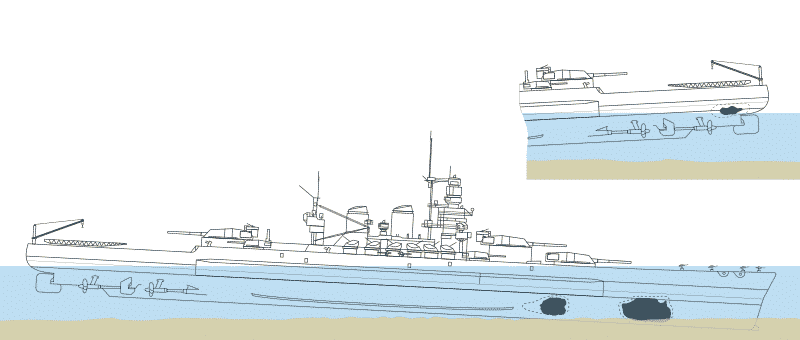
Battle damage of the littorio at tarento, 11 November 1940
On the night of 10–11 November, a famous air raid with 21 Swordfish planes from HMS Illustrious fell on Taranto by night. They attacked in two waves and were met by the withering fire of twenty-one 90 mm anti-aircraft guns and many other Breda 37 mm and 20 mm guns plus the blocking effect of twenty-seven barrage balloons. Without radar, surprise was complete, at 20:35. Littorio was caught without sufficient anti-torpedo nets protection. Therefore she took three hits (Caio Duilio one, as Conte di Cavour). Although they were “light” aerial torpedoes, Littorio, hit twice in the bow and one in the stern had her rudder steering gear destroyed, plus a massive flooding at the bow. Her famous Pugliese protection failed, and she partially sank, resting on her bow, her main battery turrets partially submerged. The days afterwards, the safety team discovered a fourth unexploded torpedo under her keel and removing it was painstaking due to its magnetic detonator. It was done on 11 December and the ship could be towed for repairs, which lasted until 11 March 1941.
Convoy operations: Halberd, M42, M43, Sirte I & II
Littorio participated in another sortie on 22–25 August 1941. And another in September (Operation Halberd) on 27 September. The convoy was covered by no less than the battleships Rodney, Nelson and Prince of Wales, spotted by reconnaissance, and the Italian commander under orders broke off the interception and returned to port. On 13 December, another attempt was broken off after Vittorio Veneto was torpedoed by a British submarine. The fleet sailed again three days later for Operation M42. However these interceptions were thwarted mostly because by late 1941, the Enigma code has been broken. Axis convoys could be intercepted at will while trying to reach North Africa. Littorio engaged the escort of a British convoy bound to Malta and opened fire at extreme range (circa 35,000 yards or 32,000 m), scoring no hits. However this forced the British force to withdraw, but the axis convoy M42 reached North Africa unscathed.
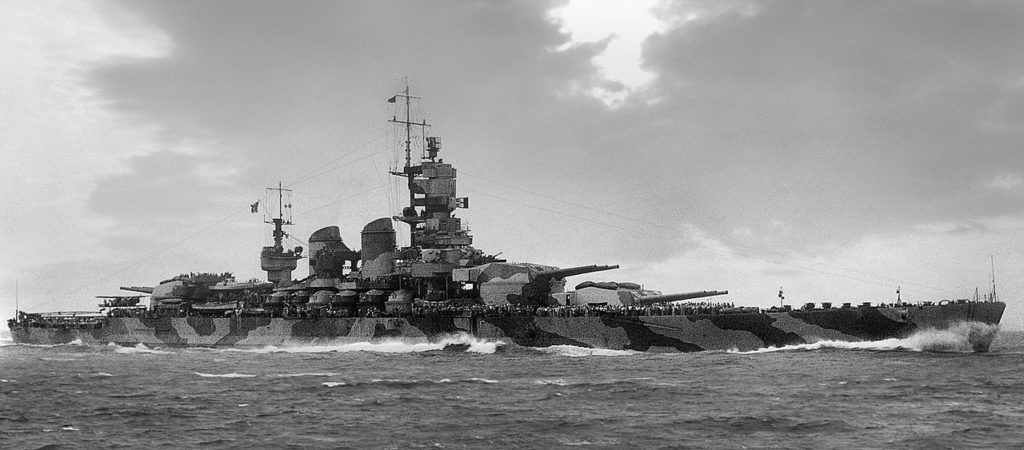
Littorio in the summer of 1942 with her particular rounded stripes camouflage, dark grey of light blue grey.
On 3 January 1942, Littorio was sent to escort a new convoy, Operation M43, successfully. On 22 March, the Second Battle of Sirte started. The battleship was then flagship for the Italian fleet, sent to intercept British convoy for Malta. To protect hut as darkness fell, three several British destroyers were detached to sail to Littorio and attack her, at close-range, repelled by an efficient fire from her main and secondary guns. Nevertheless, one arrived at a short range, enough to fire a single 4.7-inch (120 mm) shell, causing minor damage. Littorio would later hit and seriously damage HMS Havock and Kingston and the cruiser Euryalus. Kingston was repaired later in Malta. Littorio at last had the chance of a fight where she can shine, and sent 181 shells on the British convoy’s cover, never reaching the convoy itself. The transports scattered and were mostly sunk later by air attacks.
On 14 June 1942, Littorio tried to catch another British convoy, to Malta (Operation Vigorous), from Alexandria. Littorio teamed with Vittorio Veneto, four cruisers and twelve destroyers but they were spotted by British forced, launching several night air strikes on their path, but scoring no hits. The next day, bombers arrived above the formation and Littorio was hit by a B-24 Liberator’s bomb, blasting the roof of the “A” turret with light damage to the rangefinder hood and barbette and splinters in the deck. This was enough to block the turret but Littorio carried on. The threat from both battleships had the British convoy aborted and soon after, the Italians broke off in turn. But while on their way back by night, Littorio was attacked by British Wellington toredo bombers, and took one hit, flooded by 1,500 long tons of seawater in the bow area. Counter-flooding 350 long tons the crew managed to counter the list and she was back in port for repairs until 27 August, remaining in Taranto until December, then she moved with the rest of the fleet to La Spezia.
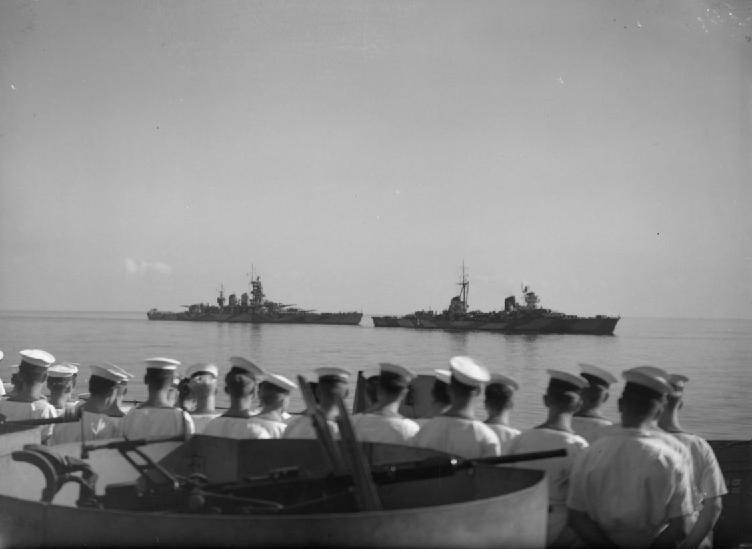
Surrender of the Italian fleet, seen from HMS warspite.
Littorio was inactive in 1943 due to fuel shortages and whatever was available for the two battleships and the recently commissioned Roma, was kept for emergencies. On 19 June 1943, USAF bombing raids started. La Spezia was hammered and Littorio received three bombs. After Mussolini’s government fell, she was renamed Italia on 30 July and with the 3 September armistice, Italia was prepared with the rest if the fleet to move for internment. It was decided the fleet would join Malta, to remain there until the remainder of the war. However meanwhile, all-out hostilities broke out with the Germans, which seize ports and ships, and the Luftwaffe soon targeted the Fleet on its way. For the first time Dornier Do 217s were fitted with Fritz X radio-controlled bombs, ancestor of antiship missiles. One hit Italia (ex-Littorio) forward of turret no. 1, going through and out of the hull and exploding below the keel, causing considerable damage. Roma was more badly hit and sunk as a result.
Italia managed to reach Alexandria, and entered the Suez Canal 14 September to remain there until 5 February 1947, whe she was fuelled to depart again for the mainland. However the peace treaty attributed the battleship on 10 February to the United States as a war prize. Refused, she was stricken on 1 June 1948 and BU at La Spezia.
RN Vittorio Veneto
Named afte the decisive Battle of Vittorio Veneto over the Austro-Hungarians in 1918, the second battleship of the Littorio class was also one of the most active during the war. She had been laid down the same day as her sister ship in the Cantieri Riuniti dell’Adriatico in Trieste, and completed in October 1939, although her fitting out period and trials and other post-trials modifications delayed her service entry in April 1940. But she was never really operational before August, as Italy entered war. Until 2 September 1940, she was part of a five battleships, ten cruisers, and thirty-four destroyers force sent to intercept Convoy MB.3, with no avail. On 6 September, same secenario against a force leaving Gibraltar, but the latter took the path westwards, to the Atlantic. On 29 September, new sortie against MB.5, the Regia Aeronautica spotted the convoy, but it was already too far away to intercept. The abense of good coordination with aviation and radars was each time a real problem and prevented the Navy to achieve seemingly easy victories. On 10–11 November, during the attack on Taranto Vittorio Veneto remained undamaged and therefore she became the fleet flagship (Admiral Inigo Campioni), participating in many engagements in the months coming.
Battle of Cape Spartivento
As her sister ships were in repairs, on 17 November, Vittorio Veneto and Giulio Cesare attempted to intercept a convoy to Malta (one of many) called Operation White. They failed to made contact. On 26 November this was Operation Collar, and this time both fleets met off Cape Spartivento (Cape Teulada for the Italians). Campioni’s forces comprised outside the two capital ships, six cruisers, and fourteen destroyers. The British escort however included the aircraft carrier Ark Royal, battleship Ramillies, and battlecruiser Renown. At first Italian aerial reconnaissance exaggerated their strength. Campioni was then under orders to not take too much risk and broke off, however Vittorio Veneto which had the range, started in between shelling British cruisers at 27,000 metres (17 miles), firing 19 rounds in seven salvoes and slightly damaged HMS Manchester. HMS Ark Royal launched its Swordfish torpedo bombers on the Vittorio Veneto, which evaded the torpedoes.
Naples, La Spezia and Sardinia
Naples proved a too exposed target for British bombers and so Supermarina, the High Command ordered Vittorio Veneto and the rest of the fleet to Sardinia on 14 December, returning to Naples later, but it was realized that Sardinia was an ideal base to intercept convoys from Gibraltar to Alexandria. On the night of 8–9 January 1941 Vickers Wellington bombers attacked Naples, damaging Giulio Cesare. Both battleships moved to La Spezia. Vittorio Veneto thus became the only operational battleship of the Regia Marina, as Giulio Cesare was in repairs until February, soon met by Andrea Doria. The three made a sortie with eight destroyers, to catch Force H on 8 February but both forces missed each others and the Italian returned to La Spezia.
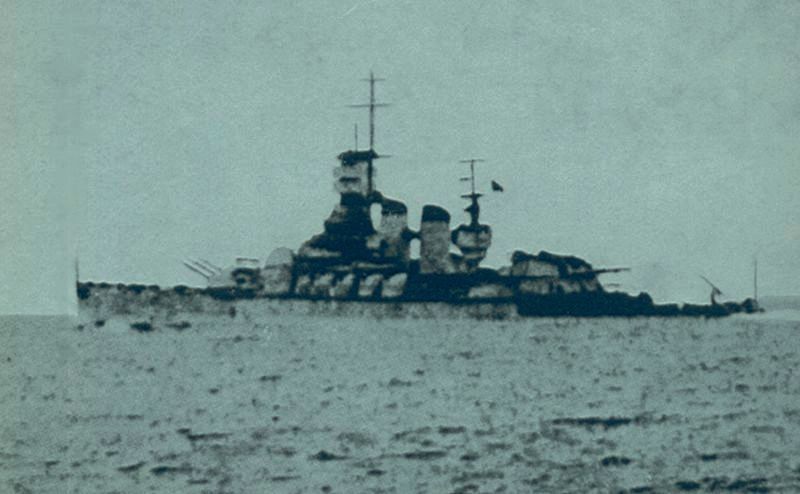
Veneto sailing out of Matapan, torpedoed.
Battle of Cape Matapan
Vittorio Veneto was in Naples on 22 March with the fleet, four days later it sortied alone to attack British forces off Greece, with eight cruisers and nine destroyers, speed was the essence and Veneto was much faster than the other two battleships. Not ony air covered was to be assured by the Regia Aeronautica but also the German Fliegerkorps X. Off the Battle of Cape Matapanbot forces met. The Trento-class heavy cruisers and Bolzano (Vice Admiral Luigi Sansonetti) met cruisers of the 15th Squadron. Iachino tried to catch the engagement with Vittorio Veneto, east of the British cruisers but HMS Orion spotted her before she was in range and the cruisers just evaded the trap. Vittorio Veneto fired anyway but just splinter damaged Orion and latter poor visibility plagued action, notably the British cruiser’s smokescreenss. In all, Veneto fired 92 rounds.
Meawnhile, HMS Formidable arrived on the scene, and its TBs attacked Vittorio Veneto, breaking off in turn the engagement and started dodging torpedoes. Air attacks went on in an attempt to to slow down Vittorio Veneto, including land-based Blenheim bombers from Greece and Crete. At 15:10 one of Formidable’s Swordfish hit Vittorio Veneto on her port side aft which sheared off the port side propeller, damaged the shaft and jammed the port rudder while the aft port pumps were also disabled. Severe flooding started before safety teams were able to call out the damage, the shp took some 4,000 long tons weawater, giving a 4–4.5 degree list and full stop after ten minutes. Then came a new Blenheim attack. There was a near-miss close to the stern but minor damage to stern. With counter-flooding the list was reduced and the starboard shafts were restarted while steering used the backup hand-steering gear allowing the ship to resume her trip at 20 knots on her starboard shafts. A new air strike of nine Swordfish arrived, but found and struck RN Pola, having huge consequences as the two other returned to assist her, to be blown to pieces during the night, making this rather indecisive engagement a resounding British victory. Due to repairs, Vittorio Veneto was out of commissioned until August 1941.
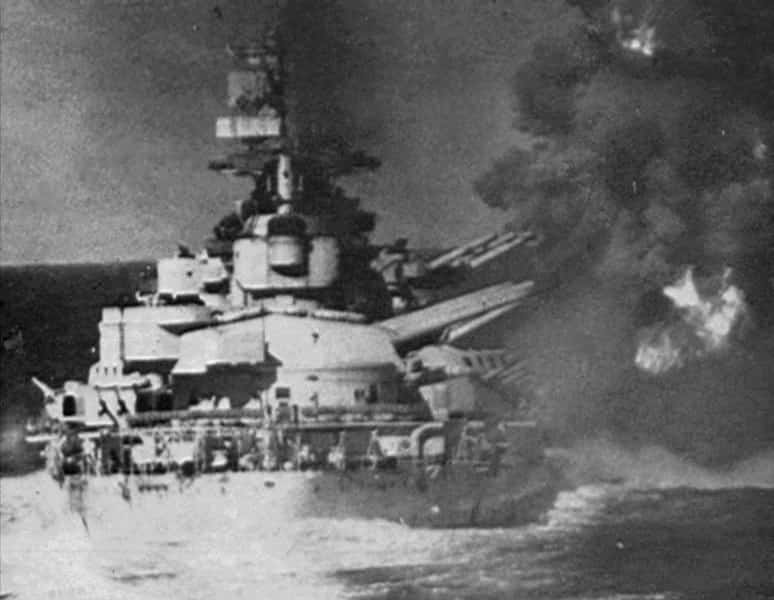
Vitorrio Veneto firing at Gaudos, Battle of Matapan
1941-42 Operations
Still under command of Iachino, Vittorio Veneto and Littorio made an unsuccessful attack sortie on 22–25 August mine as the British attempted to mine the waters of Livorno in addition to an air raid in northern Sardinia, the Italians were posted far too in the south as aerial reconnaissance once again failed to locate the British fleet. On 27 September, Vittorio Veneto with Littorio led a fleet of five cruisers, and fourteen destroyers to attack the convoy of Operation Halberd. However this was to lure out the Italian fleet on a distant escort made of the Rodney, Nelson, and Prince of Wales. Reconnaissance failed again and no contact was made but Italian torpedo bombers managed to attack the British formation and hit Nelson.
On 13 December, this was this time a convoy protection mission to North Africa. The convoy departed to broke off after a successful British radio deception. On her way back, Veneto was spotted and torpedoed by the British submarine HMS Urge off Messina and one hit on her port side, blewing up a hole 13 m (43 ft) long. She started listing and took 2,000 tons of seawater, but despite of this, the Pugliese system somewhat contained the explosion. Counter flooding and pumping allowed her to steam her way back to port, and then Taranto for repairs, until early 1942.
On 14 June 1942, Vittorio Veneto was part of the naval force deployed for Operation Vigorous. The British spotted the Italian fleet and launched air strikes with Wellington and Bristol Beaufort bombers. They scored no hits but on the cruiser Trento, flooded and an easy target later for later for a British submarine. B-24 Liberators from the USAAF also attacked the fleet, making only near misses and no damage. Later, Beauforts attacked again, but axis air cover was efficient and repelled the attack. By the afternoon of 15 June, Iachino realized there was no way to reach the convoy before dark and order to broke off the operation. In the meantime howver, the convoy had been ordered back to Alexandria, never making it to Malta, a British failure by default, compensated by a torpedo hot on Littorio on her way back.
Operation Torch and consequences
On 12 November, Vittorio Veneto moved to Naples, to have a better launching spot after the Allied invasion of North Africa. However she was caught en route by the British submarine HMS Umbra, which failed to score any hit however. However, the fleet soon had to evacuate Naples after an USAAF raid, back to La Spezia, remaining until the capitulation. On 5 June 1943, Vittorio Veneto was badly damaged by USAF bombers, and she was transferred to Genoa for repair, which went one until 3 September, and the armistice. On 9 September, Vittorio Veneto and the rest of the fleet sailed for Malta when they were attacked underway by Do 217s with Fritz X radio-controlled bombs. Vittorio Veneto was only one spared, making it in Malta and remaining there until 14 September, then Alexandria and the Great Bitter Lake for storage in October. Italia and Veneto remained there until 6 October 1946, returning to Italy. The peace treaty signed on 10 February 1947 saw Vittorio Veneto allocated to Britain, but she was paid off on 3 January 1948, stricken and sold for BU. Some of her 90mm AA guns saw action with the Yugoslav People’s Army and were surrended during on 14 September 1991 (Croatian War of Independence), after quite an active use during the Battle of Šibenik.
RN Roma
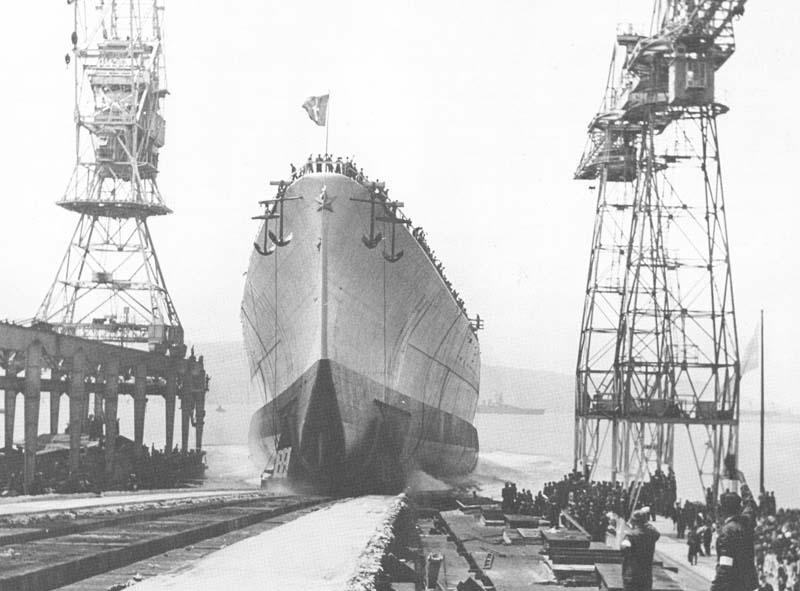
Roma’s launch, 9 June 1940
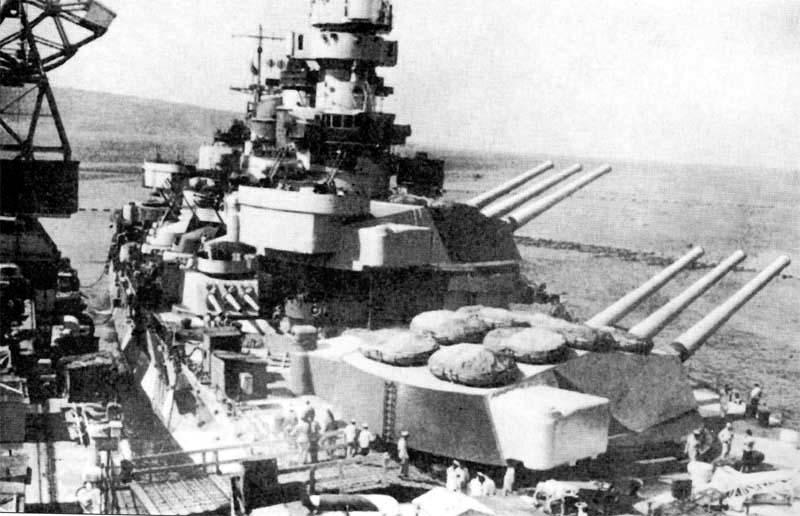
Roma’s final outfitting in the summer of 1942
After commission and training, RN Roma (Capt. Adone Del Cima) made it in the naval base of Taranto on 21 August. She was assigned to the 9th Naval Division, took part in more training exercises and Taranto, Naples, and La Spezia in 1943, seeing little combat due to late fuel shortages. On 12 November, the Allied invasion of North Africa prompted a departure of the fleet which en route were attacked by the British submarine HMS Umbra, without hit. On 4 December 1942 a major USAF raid on Naples destroyed a cruiser, damaged two others and four destroyers. Roma, Vittorio Veneto and Littorio moved to to La Spezia, and Roma, the best and most recent, became the flagship of the Regia Marina. Nothing really happened in January-February, and until early March of 1943 while La Spezia was attacked by more Allied bombers, on 14 and 19 April 1943 and on 5 June, bombs severely damaging Vittorio Veneto and Roma. These were B-17 908 kg (2,002 lb) AP bombs and Roma took two near hits but leaks were soon detecting from frames 221 to 226 on around 3m2, starting a flooding from the bow. The second near miss created more leaks one 30 sq ft (2.8 m2) and in total 2,350 long tons of seawater would entered the ship. On 23–24 June Roma was hit by another bomb aft and starboard close to the aft main turret (“X”) causing flooding from broken pipes. Another hit the turret’s rear but the heavy armor did its job. Roma had to sail to Genoa for repairs on 1 July, back to Spezia on 13 August.
Armistice and the end of Roma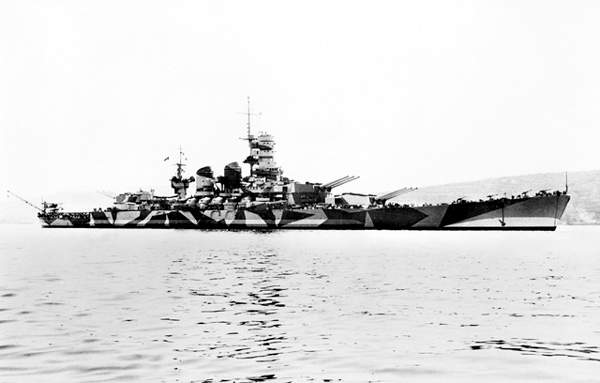
As Operation Avalanche took place, the fleet was instructed to gather and sail to Salerno. However, events changed dramatically in between: On 9 September 1943, after the armistice, the Italian fleet, comprising Vittorio Veneto, Italia and Roma, as flagship of Admiral Carlo Bergamini, plus the cruisers Eugenio di Savoia, Raimondo Montecuccoli, Emanuele Filiberto Duca d’Aosta and eight destroyers departed La Spezia and were joined by Duca degli Abruzzi, Giuseppe Garibaldi, and Attilio Regolo from Genoa, but had to turn back as the operation was cancelled.
German forces soon launched Operation Achse, and Admiral Bergamini had to flee La Spezia to avoid capture and reach Allied ports. Bergamini at frst decline to sail to Malta while Victor Emmanuel III’s court and government moved from Rome to La Maddalena on the destroyers Vivaldi and Da Noli, in Sardinia, giving no more precise orders. Once there, they communicated with Bergamini, ordering the fleet to proceed to Malta from Admiral Bruno Brivonesi and related armistice documents. The fleet arrived off La Maddalena, just captured by German troops and Supermarina ordered Bergamini to head for Bône instead. This move was catch by the Germans which soon sent several Dornier Do 217s armed with the new Fritz X radio-controlled bomb, in order to destroy the ships and prevent them falling in allied hands. The bomber spotted the fleet off the Strait of Bonifacio and the attack commenced.
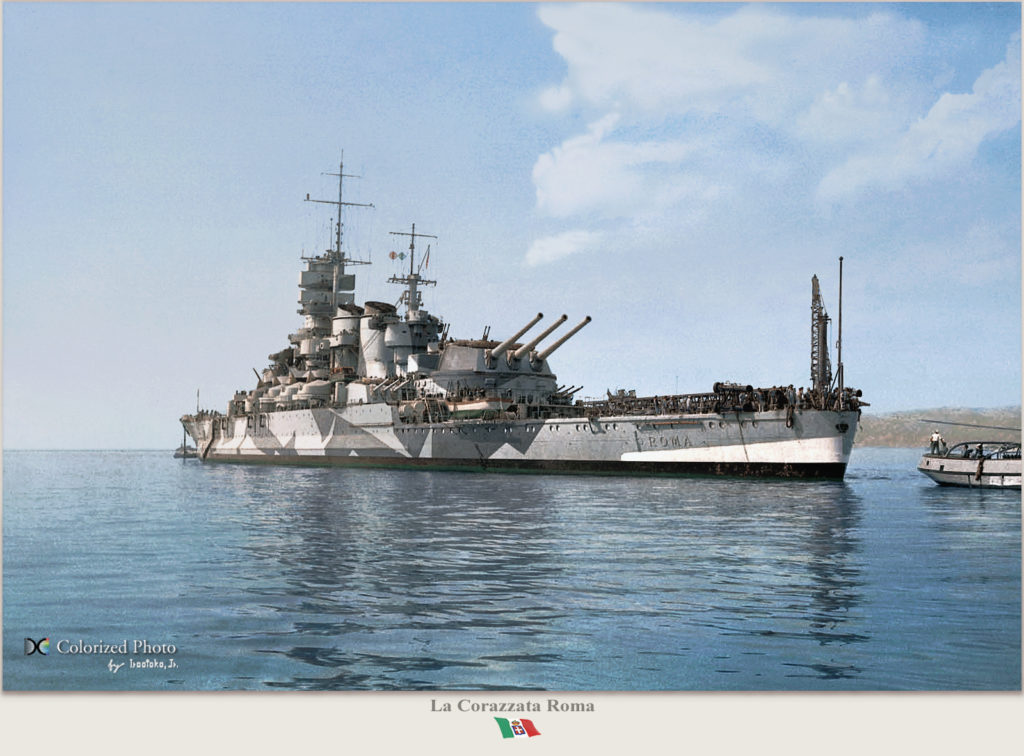
Roma in 1942, Nice colorization by Irootoko jr.
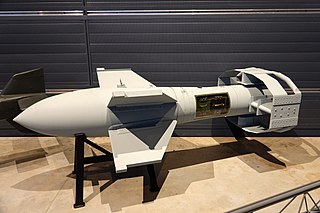 The Do 217s stayed off range from the fleet, remaining unidentified, but as the latter did not open fire as planned, not able to tell friend of foe, they stopped trailing the fleet and prepared to attack. Bergamini believed this was an allied air cover, as promised. But soon, the first Dornier attacked and launched its first guided bomb upon Italia and Roma soon after. Immediately AA batteries entered into action while the ships began evasive maneuvers. 15 minutes later, RN Italia was hit on the starboard side, as Roma, the bomb passing through the ship to explode beneath the keel. The hull girder was badly damaged and water flooding started in the after engine room and two boiler rooms, also causing the inboard propellers to stop while many electrical fires started. Soon, Roma started to loose power and speed and fall out of the battle group.
The Do 217s stayed off range from the fleet, remaining unidentified, but as the latter did not open fire as planned, not able to tell friend of foe, they stopped trailing the fleet and prepared to attack. Bergamini believed this was an allied air cover, as promised. But soon, the first Dornier attacked and launched its first guided bomb upon Italia and Roma soon after. Immediately AA batteries entered into action while the ships began evasive maneuvers. 15 minutes later, RN Italia was hit on the starboard side, as Roma, the bomb passing through the ship to explode beneath the keel. The hull girder was badly damaged and water flooding started in the after engine room and two boiler rooms, also causing the inboard propellers to stop while many electrical fires started. Soon, Roma started to loose power and speed and fall out of the battle group.
On 16:02, a now slow target, Roma was soon hit by another Fritz X, hich slammed into here starboard side on her deck, and detonated in the forward engine room. A massive ball of flames and heavy flooding in the magazines of turret “B” and fore port side, secondary turret. The already stressed hull girder ruptured and B turret was soon blown overboard by a massive explosion, coming from fire spreading to the turret’s magazines. This was followed by a catastrophic flooding causing the ship to sink by the bow while listing to starboard. It soon capsized and broke in two. 596 survived out of the 1,253 men that could not escaped Roma. According to Francesco Mattesini Admiral Bergamini’s staff was also decimated in the process. In all, the were 1,393 losses. In her short service, Roma would cover 2,492 mi (4,010 km) in 133 hours of sailing. The wreck ws rediscovered in June 2012 by Guido Gay’s underwater robot, laying down about 30 km (19 mi) off the northern coast of Sardinia under 1,000 m (3,281 ft). A memorial ceremony was held on an Italian frigate headed with emotion by Giampaolo Di Paola, defence minister and former sailor.
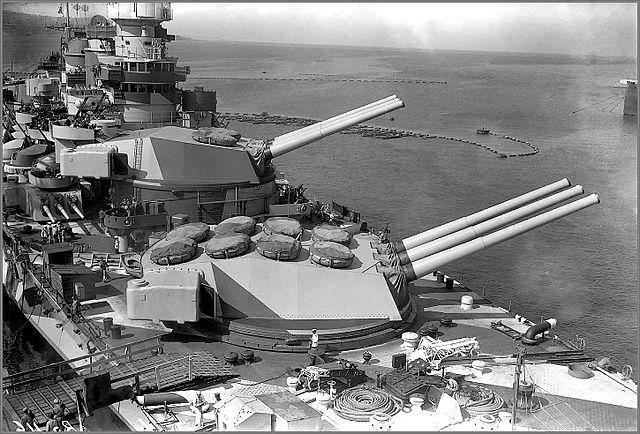
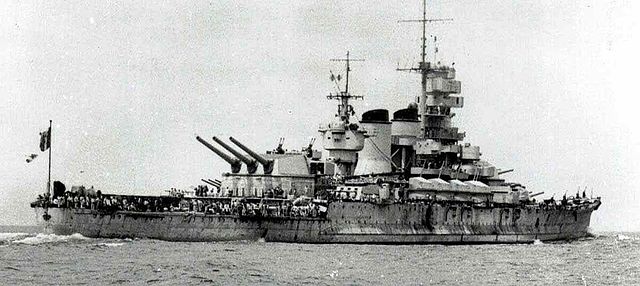
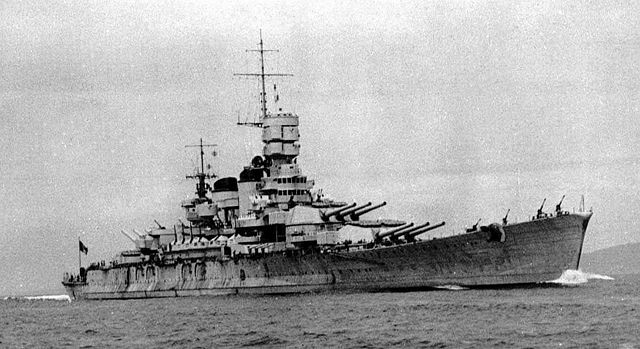
Forward turrets and starboard quarter view, stern and bow of Roma
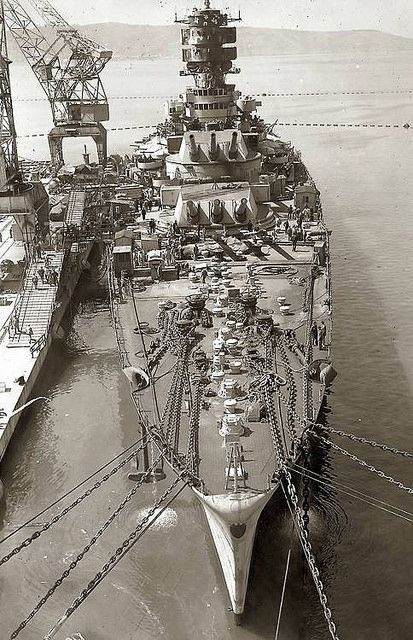
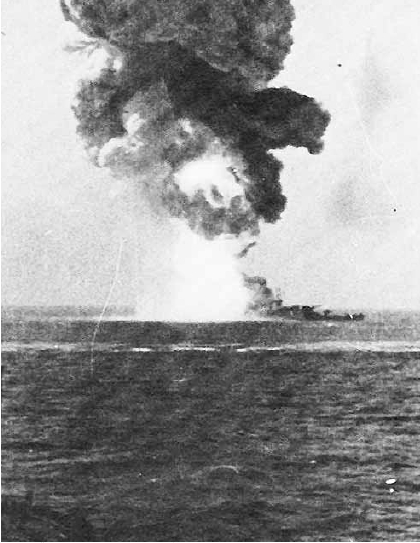
Roma sunk by the Luftwaffe on 9 September 1943
RN Impero
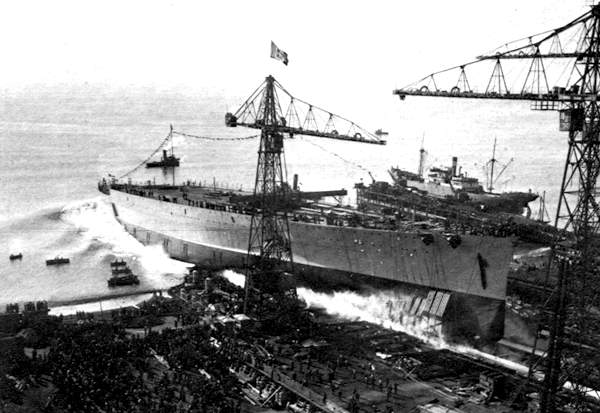
Launch of the Battleship RN Impero in November 1939
Impero was the fourth Littorio-class battleship, named after the Italian word for “empire”, recalling not the Roman Empire dear to Mussolini but the newly conquered Italian Empire in East Africa after the Second Italo-Abyssinian War. She was part of the 1938 Naval Expansion Program with Roma. The two more battleships of the Littorio class were an attempt to counter a possible Franco-British alliance, and the new Richelieu class in construction. Mussolini postponed and later authorized the planning in January 1937 FY1938, approved in december and funded. Impero was laid down in May 1938, and launched in November 1939.
Before June 1940, it was well understood that Genoa was in bombing range from France, in case of a war which seems now plausible. Therefore the hull of RN Impero was tugged to Brindisi on 8 June 1940. Trieste was preferred but the basin was already taken by Roma, fitting out. Her machinery was installed, parts of her light artillery for AA defence, but due to limited manpower and resources, construction priorities went to smaller and lighter escort vessels. RN Impero was still incomplete when bombed by an allied raid, and it was decided to fit her with additional light anti-aircraft and anti-surface guns for self defense as she had her egines installed and can now sail to Venice, departing on 22 January 1942. She later that year moved to Trieste, but left there with no work done for month.
In the end, Italy capitulated to the Allies in September 1943, Impero was seized by the Germans. At that stage, hull was 88% complete and engines were 76% complete, but only 28% of her completion was done, with the secondary and main armament, electrical wiring and bridge still missing. While her sister ships sailed to Sardinia to be escorted in Malta. At first there was no intent to complete her at that stage so she was left there, and later intended to break her up for scrap. The Germans indeed expected eighteen more months of full work to complete her. The hulk was spotted by Allied aviation over Trieste and sunk in shallow waters. The Germans used her as a target practice while another air attack on 20 February 1945 futher damaged her hulk. RN Impero was eventually stricken from the register on 27 March 1947, towed to Venice, beached, and scrapped there from 1948.
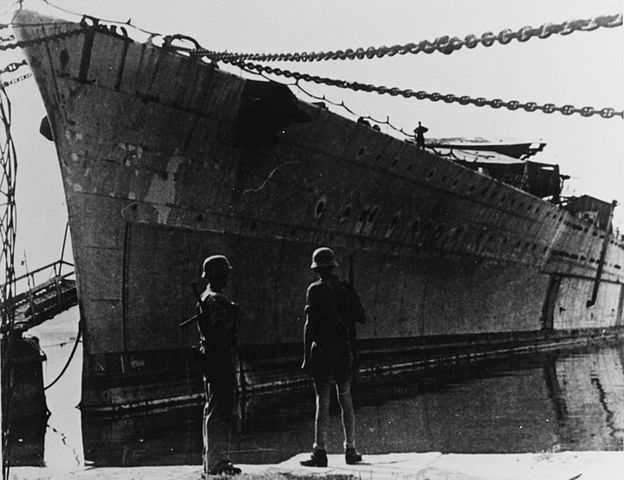
Unfinished Impero under German control.



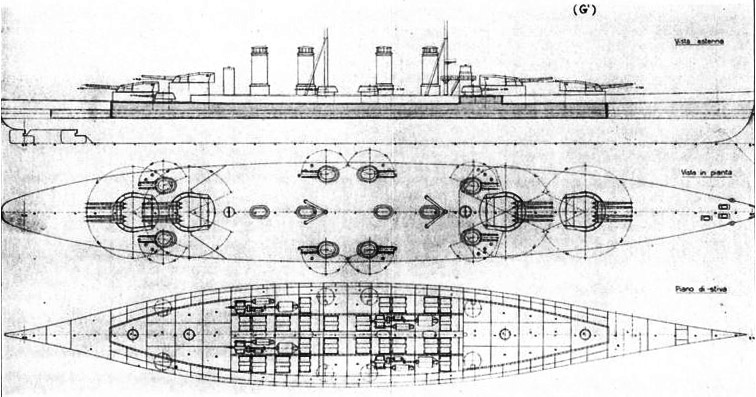
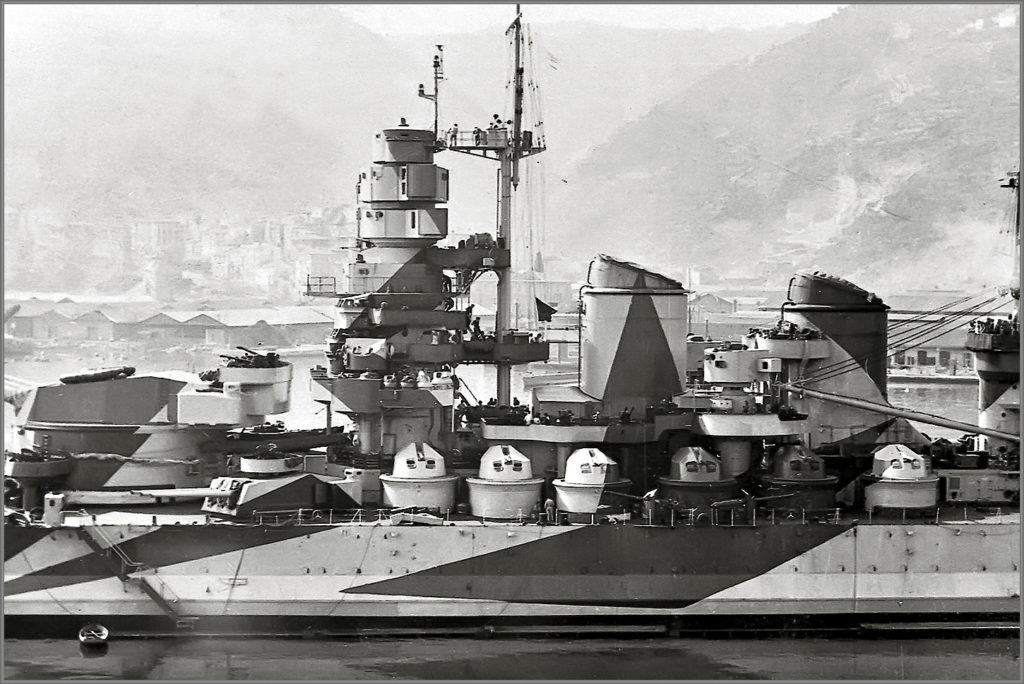

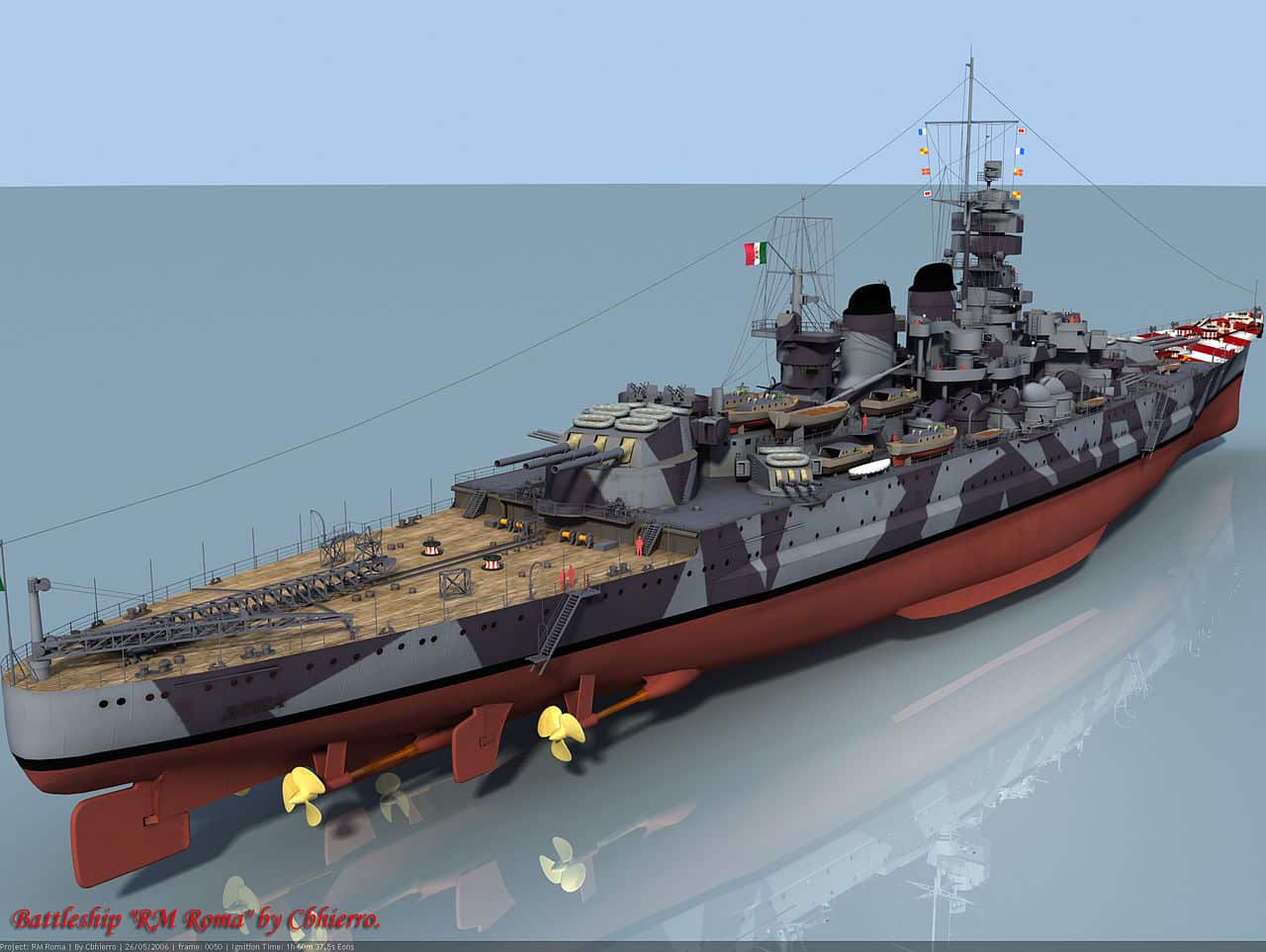


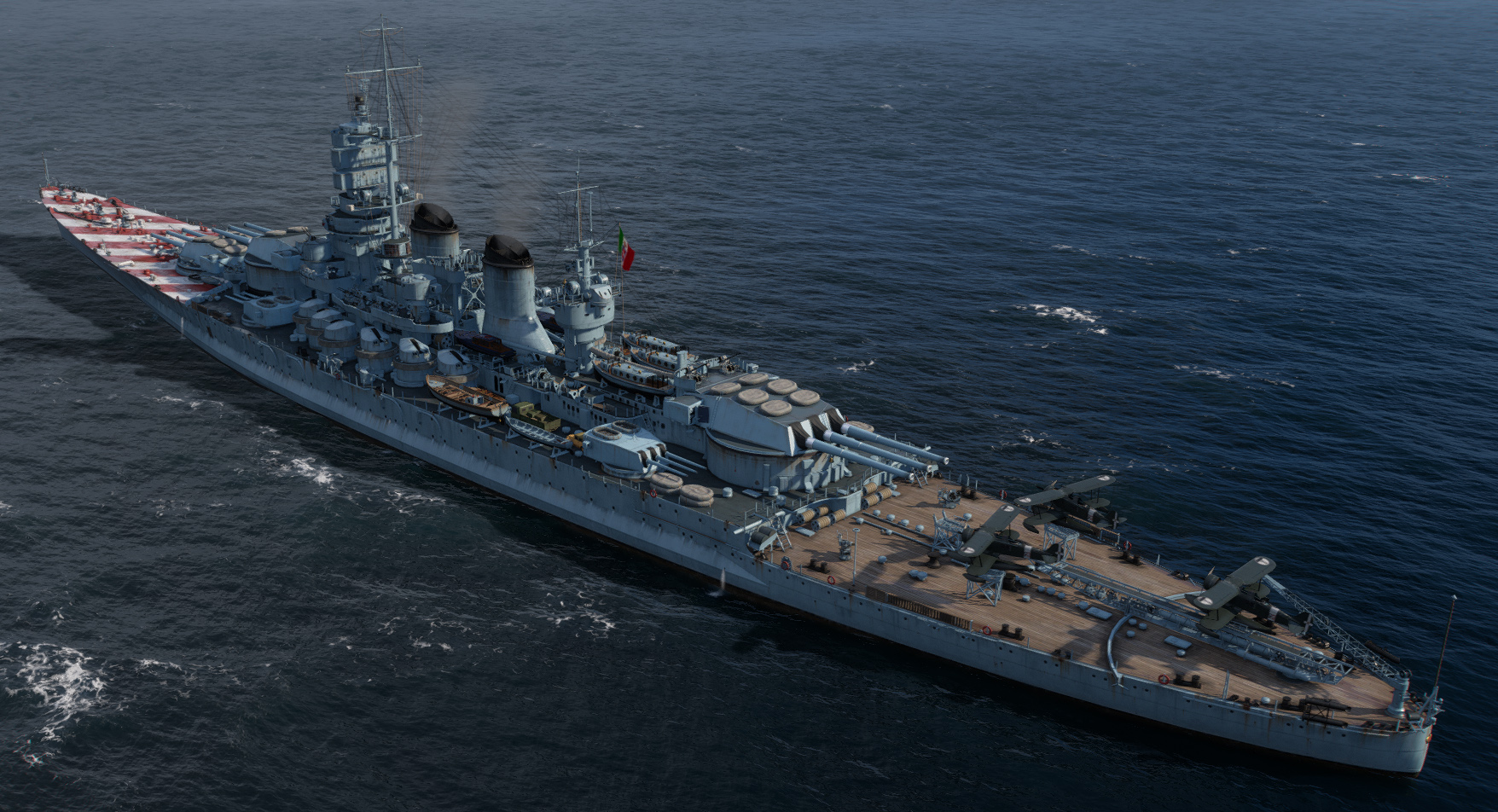
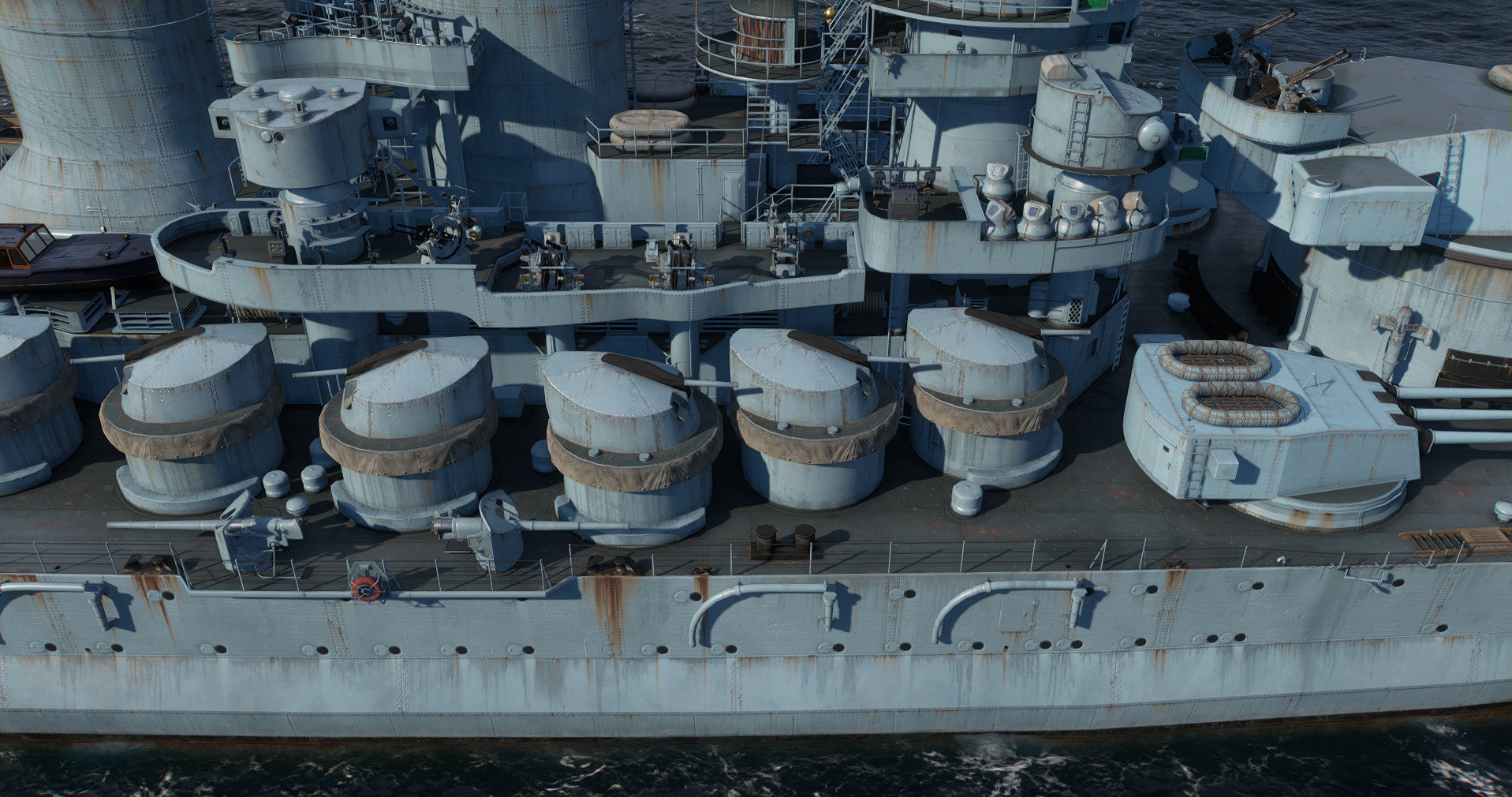
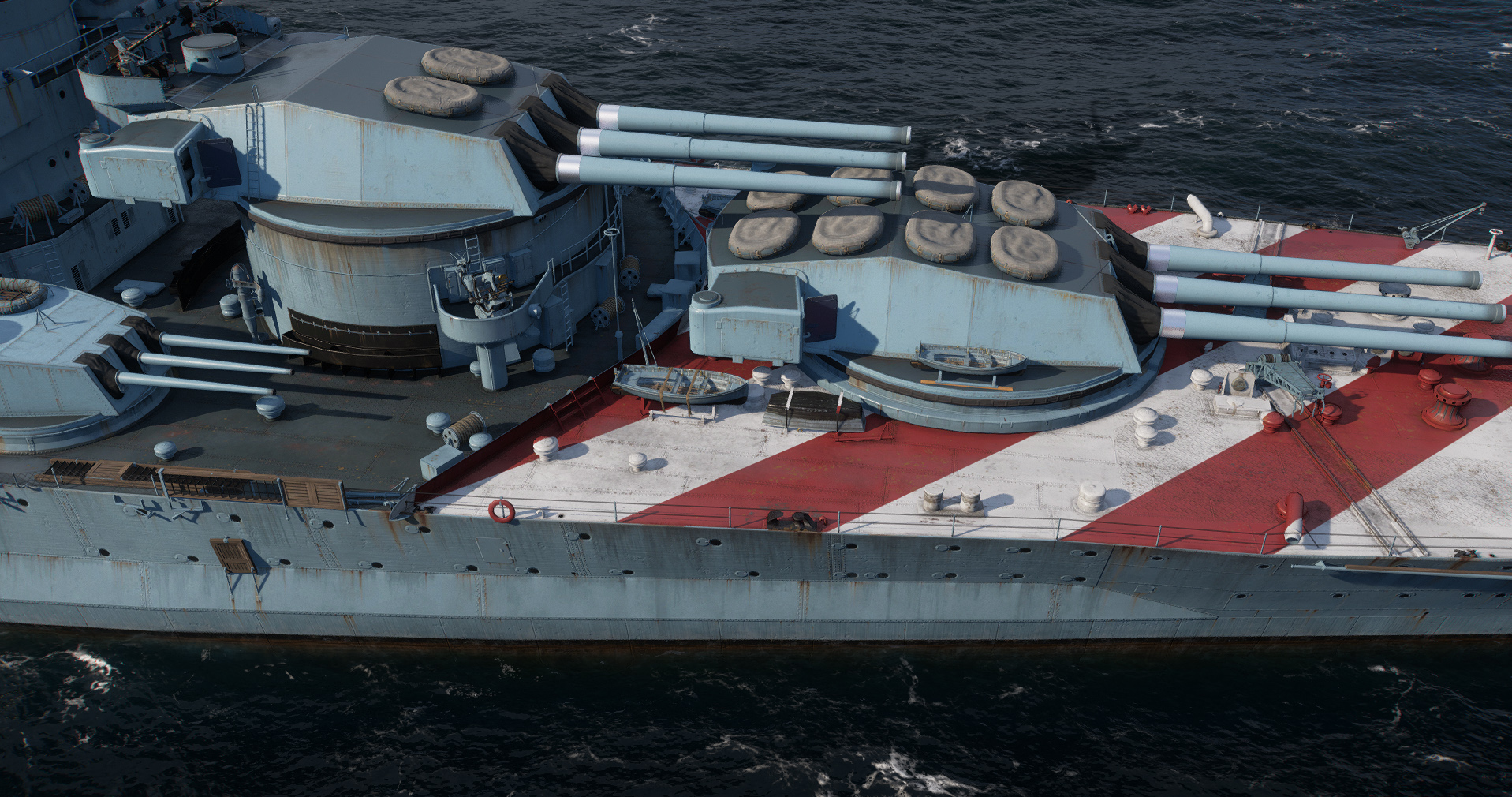

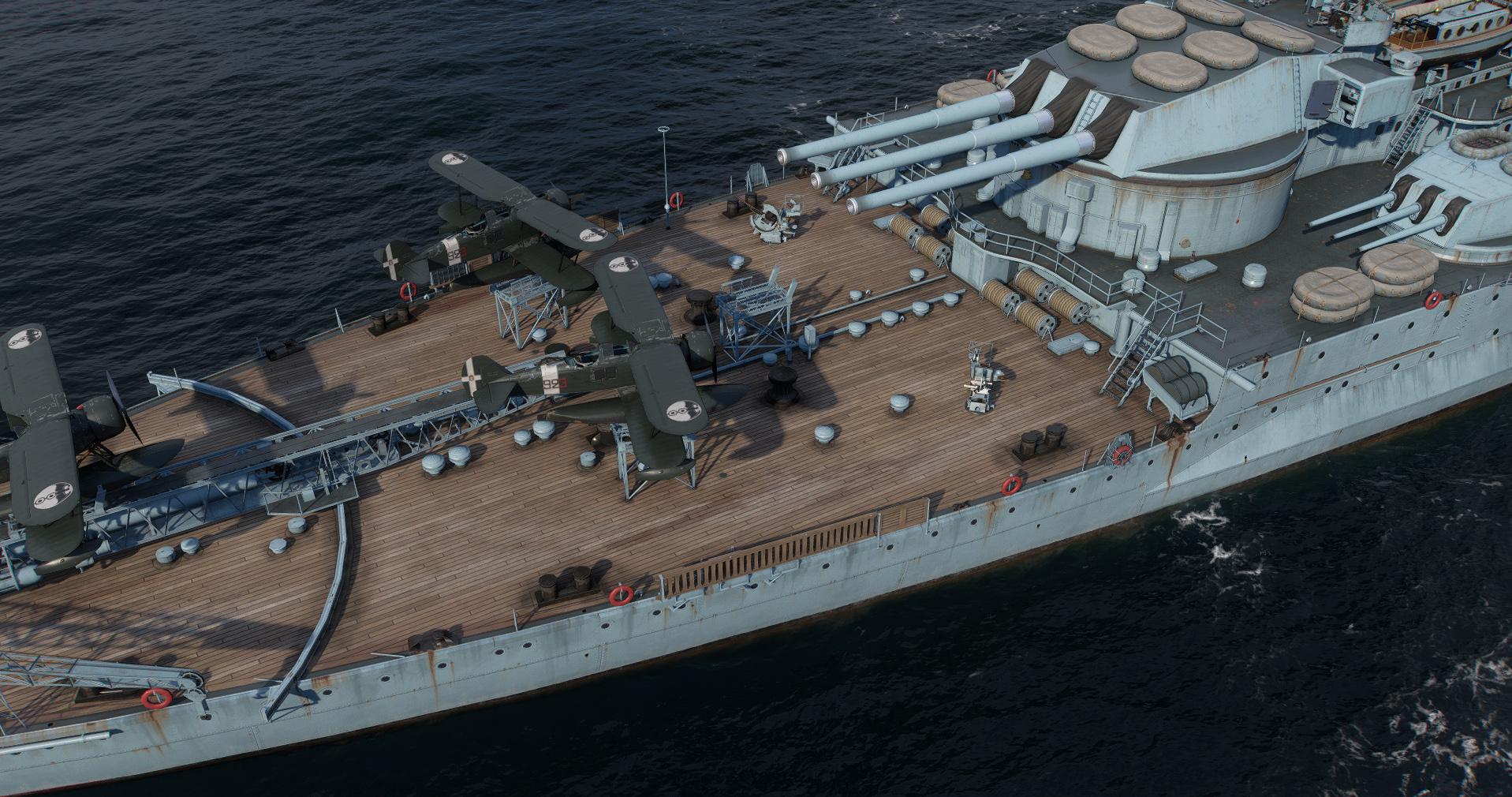
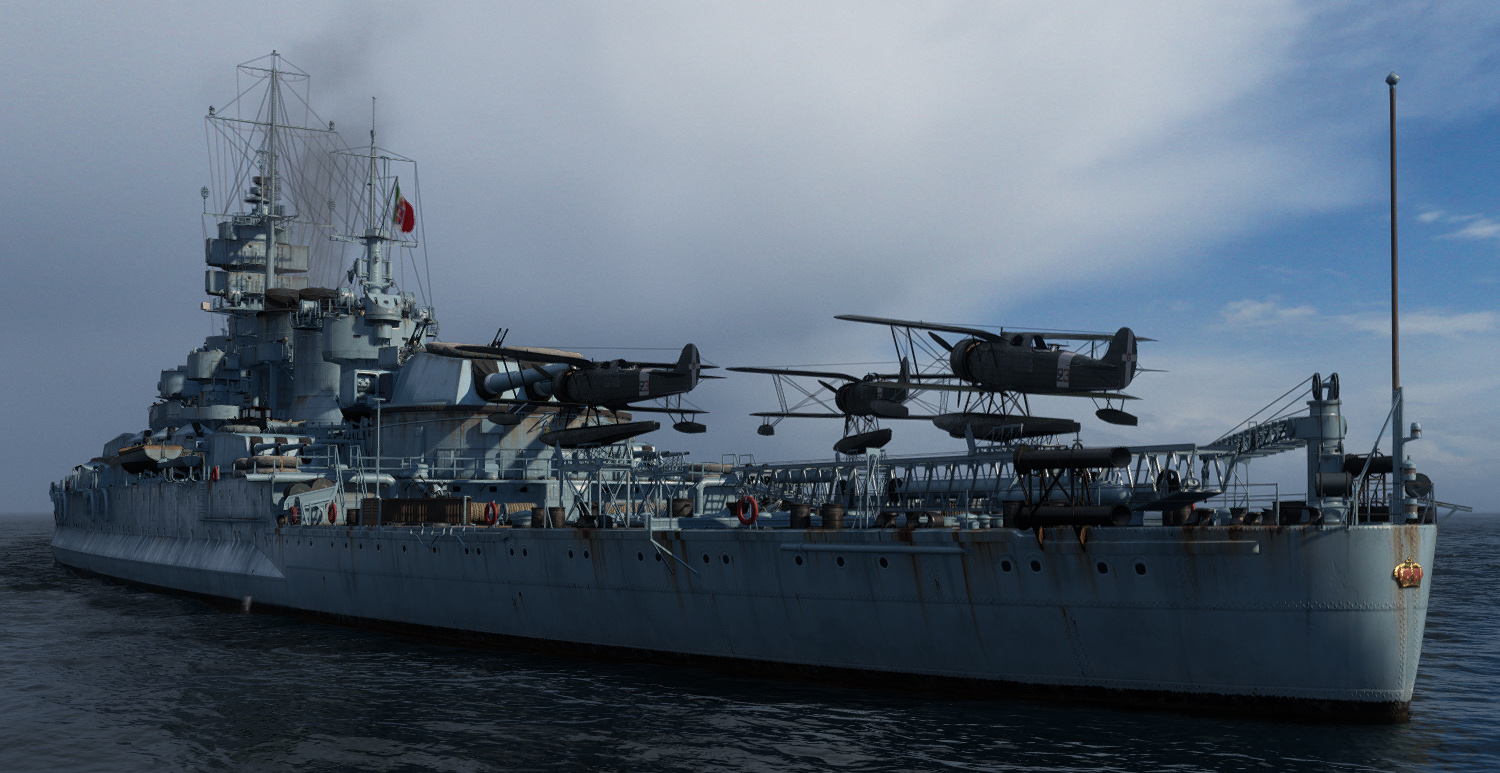
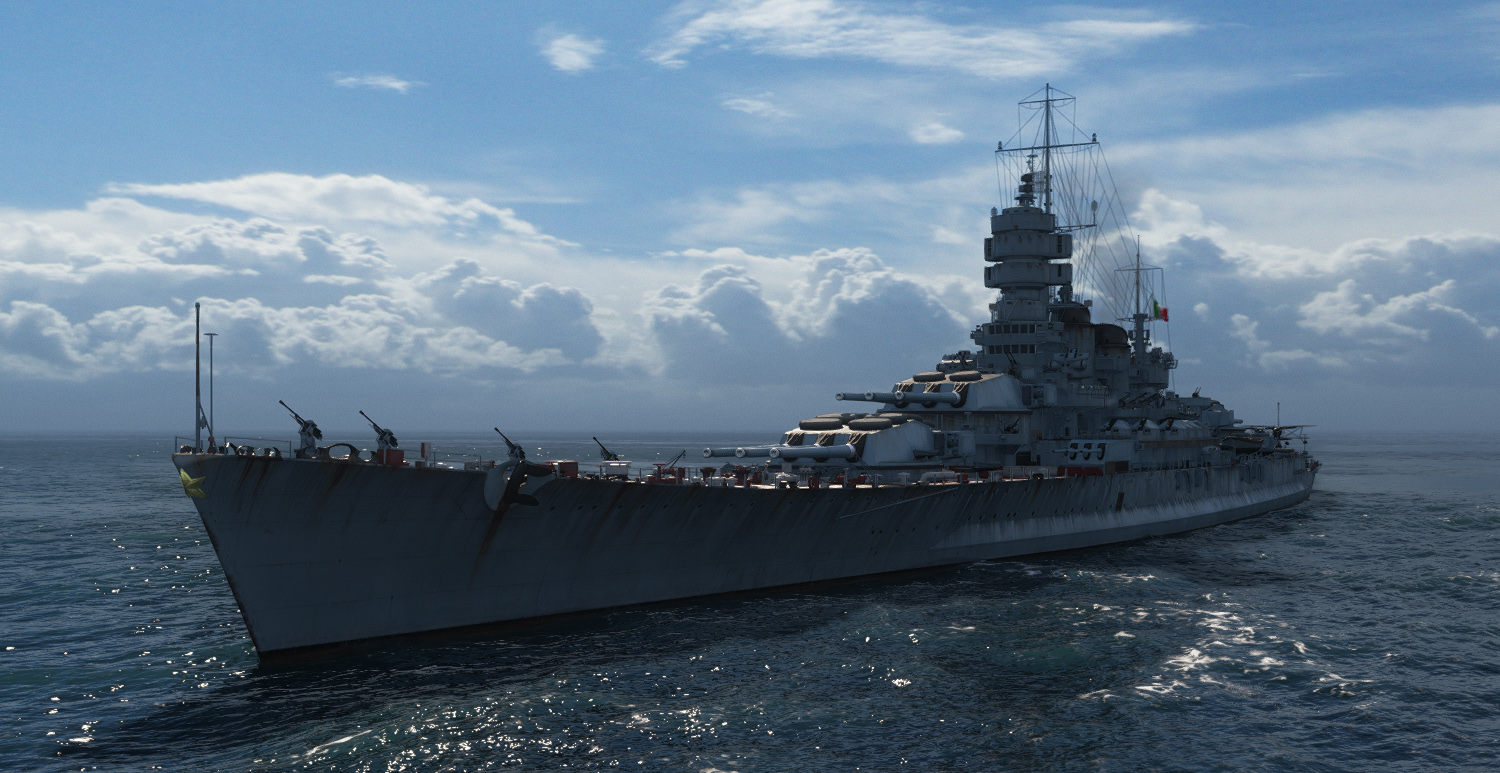
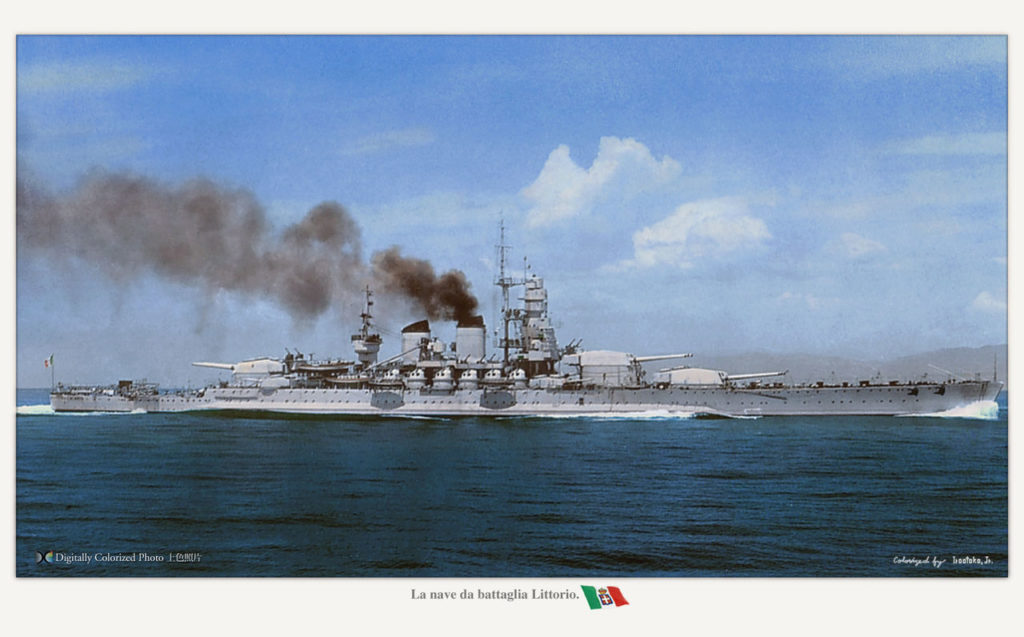
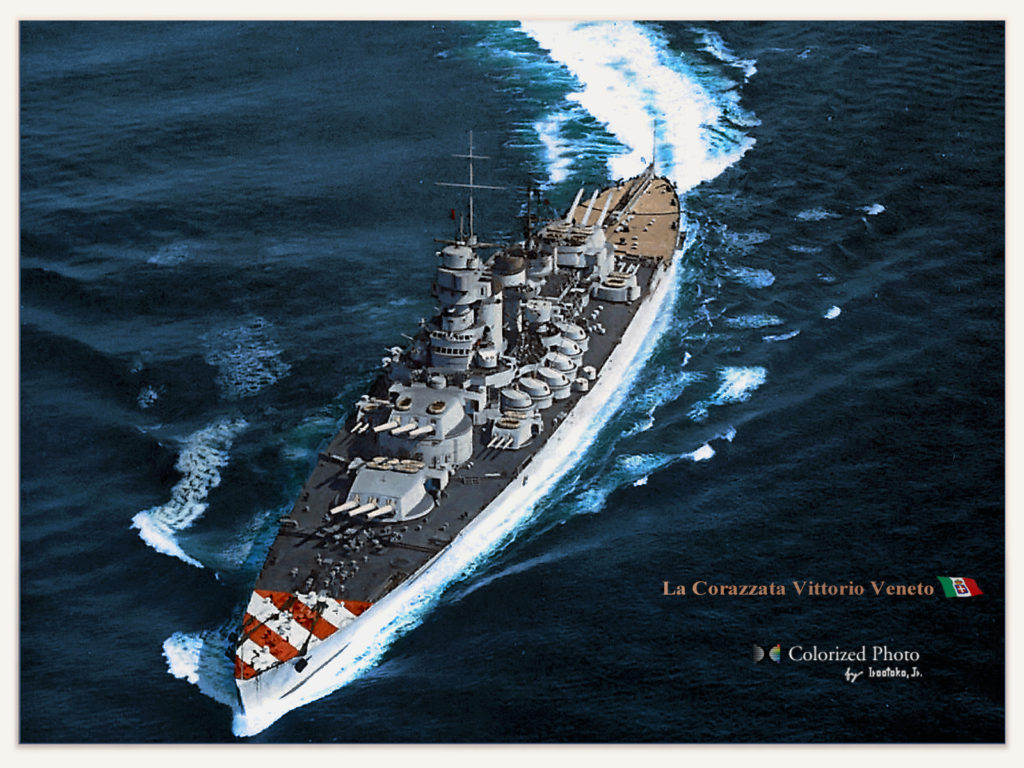
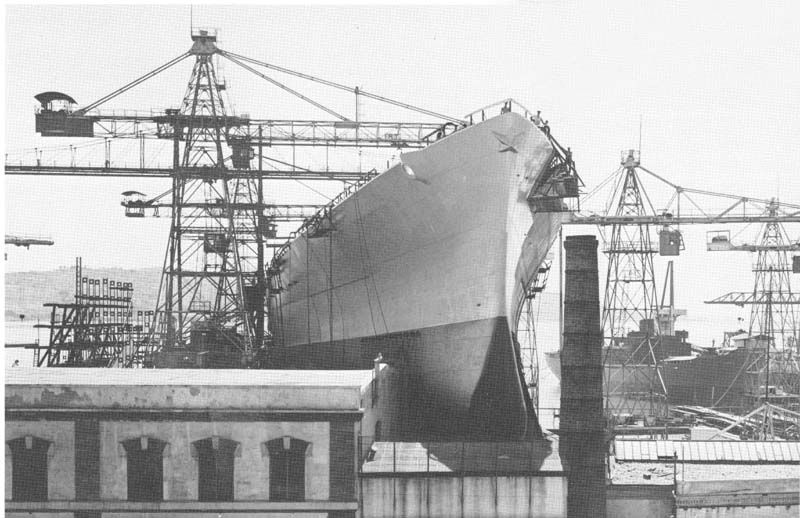
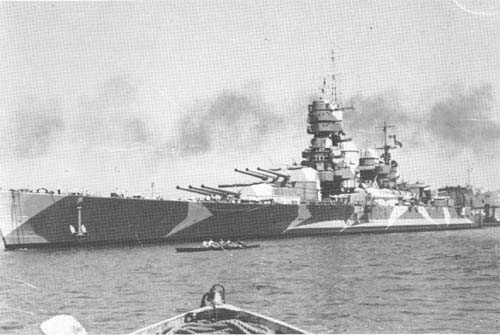
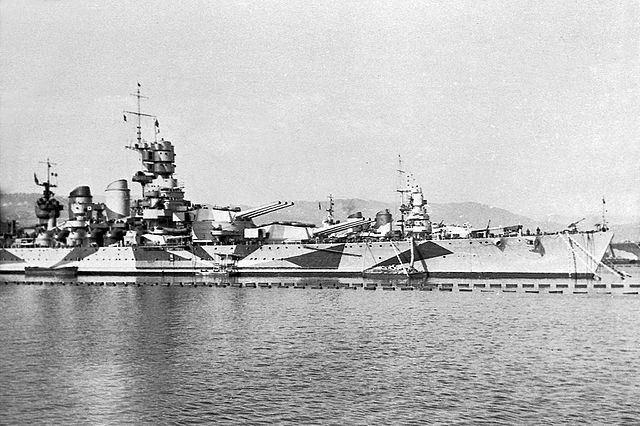
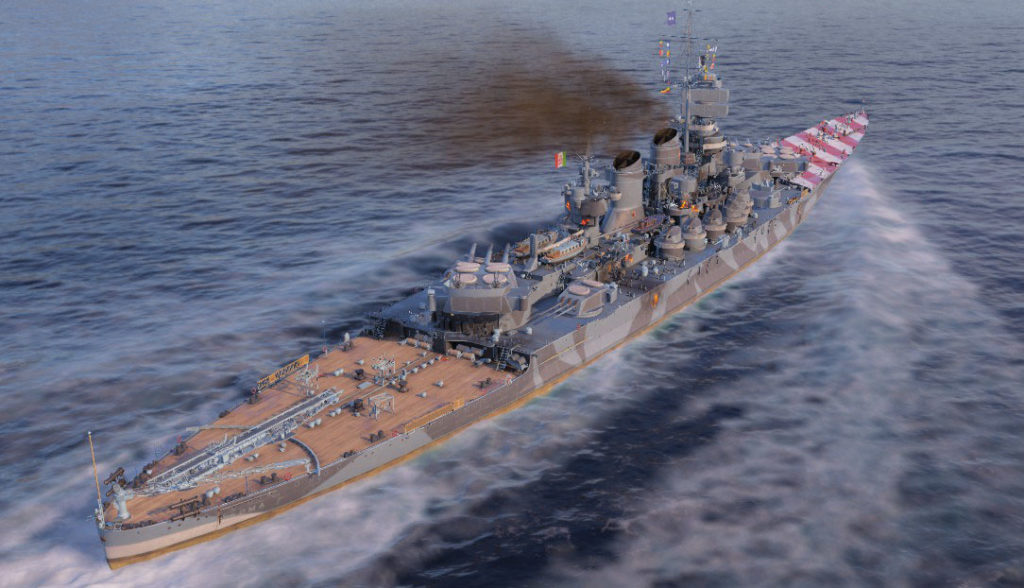
 Latest Facebook Entry -
Latest Facebook Entry -  X(Tweeter) Naval Encyclopedia's deck archive
X(Tweeter) Naval Encyclopedia's deck archive Instagram (@navalencyc)
Instagram (@navalencyc)





 French Navy
French Navy Royal Navy
Royal Navy Russian Navy
Russian Navy Armada Espanola
Armada Espanola Austrian Navy
Austrian Navy K.u.K. Kriegsmarine
K.u.K. Kriegsmarine Dansk Marine
Dansk Marine Nautiko Hellenon
Nautiko Hellenon Koninklije Marine 1870
Koninklije Marine 1870 Marinha do Brasil
Marinha do Brasil Osmanlı Donanması
Osmanlı Donanması Marina Do Peru
Marina Do Peru Marinha do Portugal
Marinha do Portugal Regia Marina 1870
Regia Marina 1870 Nihhon Kaigun 1870
Nihhon Kaigun 1870 Preußische Marine 1870
Preußische Marine 1870 Russkiy Flot 1870
Russkiy Flot 1870 Svenska marinen
Svenska marinen Søværnet
Søværnet Union Navy
Union Navy Confederate Navy
Confederate Navy Armada de Argentina
Armada de Argentina Imperial Chinese Navy
Imperial Chinese Navy Marinha do Portugal
Marinha do Portugal Mexico
Mexico Kaiserliche Marine
Kaiserliche Marine 1898 US Navy
1898 US Navy Sovietskiy Flot
Sovietskiy Flot Royal Canadian Navy
Royal Canadian Navy Royal Australian Navy
Royal Australian Navy RNZN Fleet
RNZN Fleet Chinese Navy 1937
Chinese Navy 1937 Kriegsmarine
Kriegsmarine Chilean Navy
Chilean Navy Danish Navy
Danish Navy Finnish Navy
Finnish Navy Hellenic Navy
Hellenic Navy Polish Navy
Polish Navy Romanian Navy
Romanian Navy Turkish Navy
Turkish Navy Royal Yugoslav Navy
Royal Yugoslav Navy Royal Thai Navy
Royal Thai Navy Minor Navies
Minor Navies Albania
Albania Austria
Austria Belgium
Belgium Columbia
Columbia Costa Rica
Costa Rica Cuba
Cuba Czechoslovakia
Czechoslovakia Dominican Republic
Dominican Republic Haiti
Haiti Hungary
Hungary Honduras
Honduras Estonia
Estonia Iceland
Iceland Eire
Eire Equador
Equador Iran
Iran Iraq
Iraq Latvia
Latvia Liberia
Liberia Lithuania
Lithuania Mandchukuo
Mandchukuo Morocco
Morocco Nicaragua
Nicaragua Persia
Persia San Salvador
San Salvador Sarawak
Sarawak Uruguay
Uruguay Venezuela
Venezuela Zanzibar
Zanzibar Warsaw Pact Navies
Warsaw Pact Navies Bulgaria
Bulgaria Hungary
Hungary

 Bundesmarine
Bundesmarine Dutch Navy
Dutch Navy Hellenic Navy
Hellenic Navy Marina Militare
Marina Militare Yugoslav Navy
Yugoslav Navy Chinese Navy
Chinese Navy Indian Navy
Indian Navy Indonesian Navy
Indonesian Navy JMSDF
JMSDF North Korean Navy
North Korean Navy Pakistani Navy
Pakistani Navy Philippines Navy
Philippines Navy ROKN
ROKN Rep. of Singapore Navy
Rep. of Singapore Navy Taiwanese Navy
Taiwanese Navy IDF Navy
IDF Navy Saudi Navy
Saudi Navy Royal New Zealand Navy
Royal New Zealand Navy Egyptian Navy
Egyptian Navy South African Navy
South African Navy






























 Ukrainian Navy
Ukrainian Navy dbodesign
dbodesign